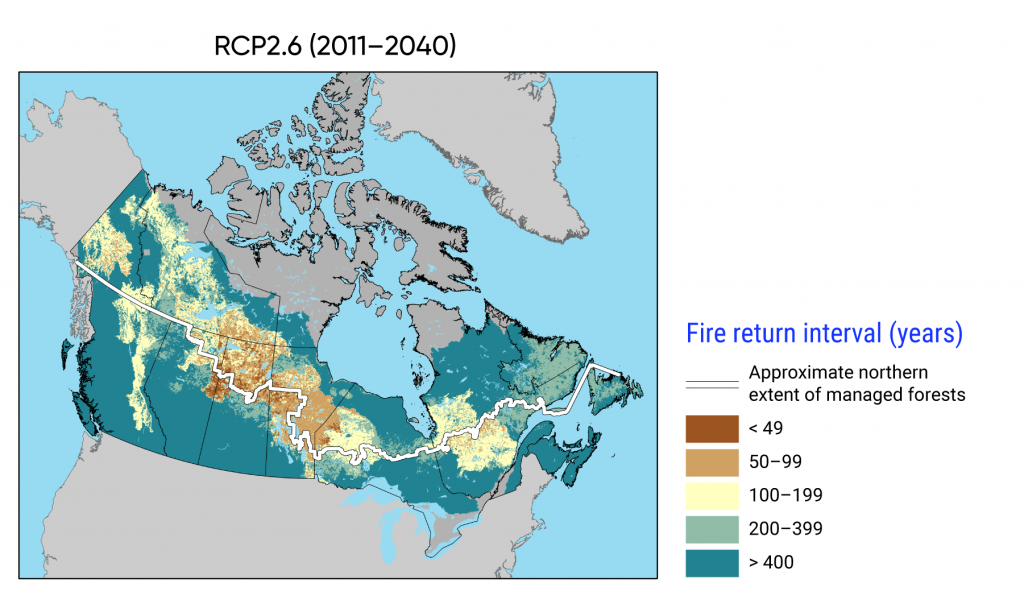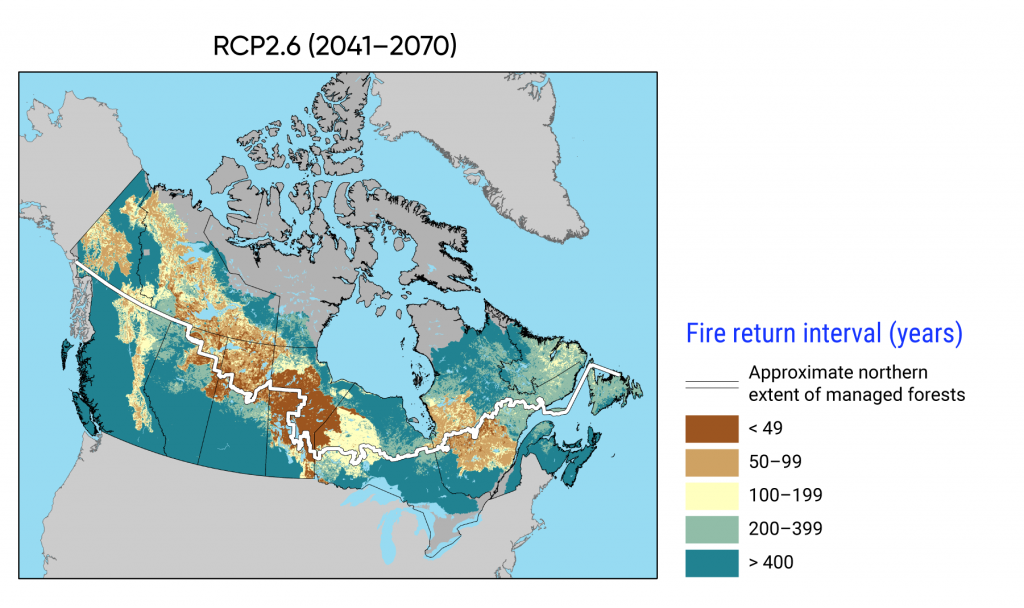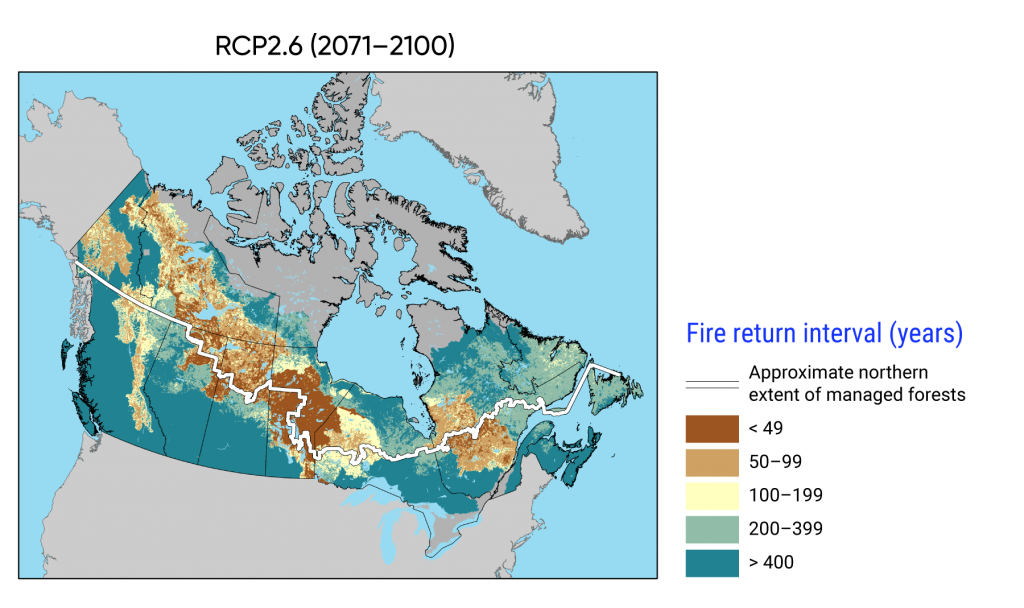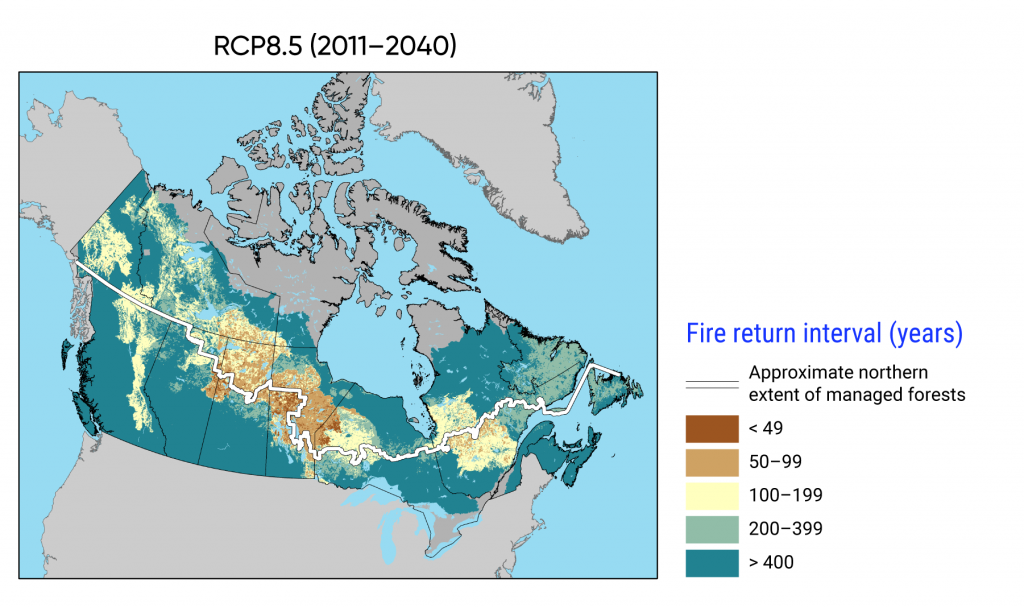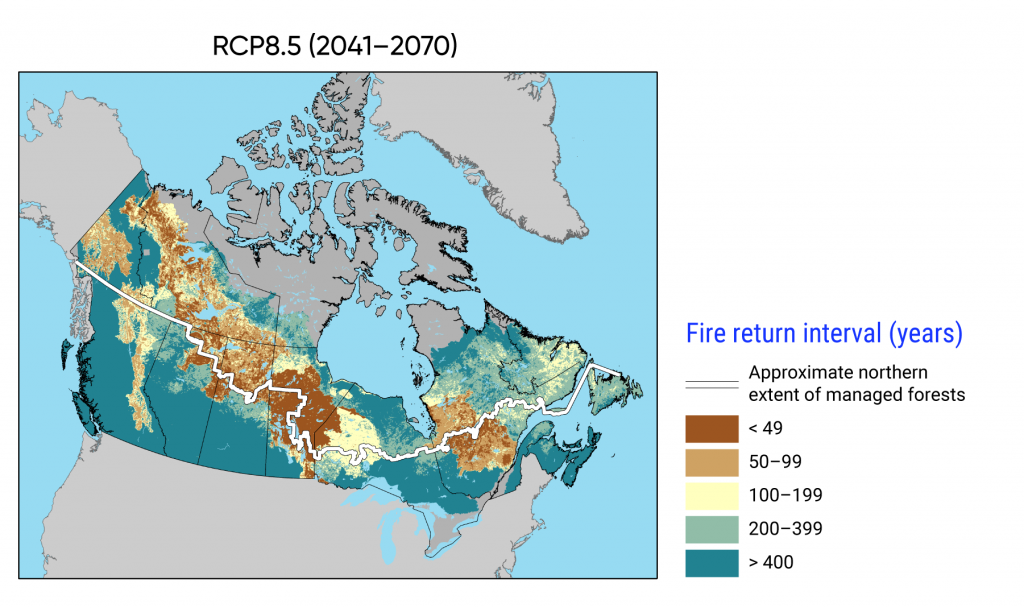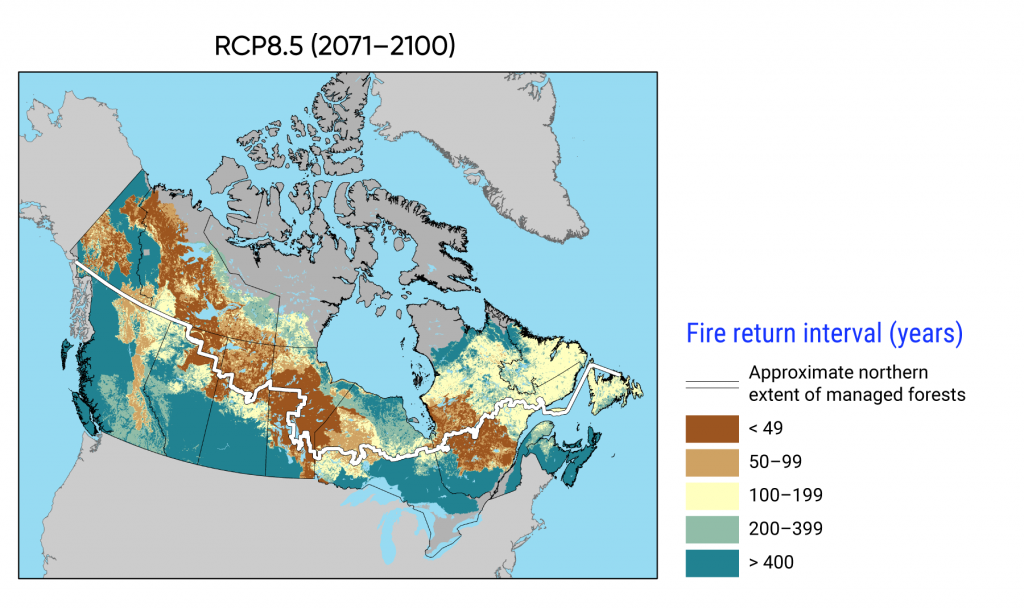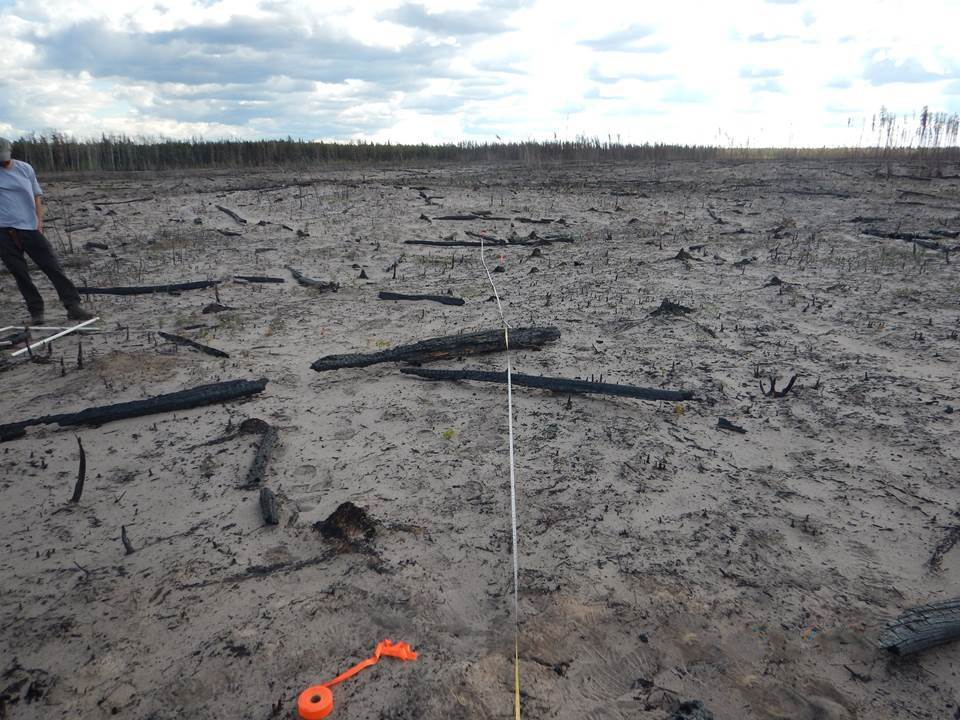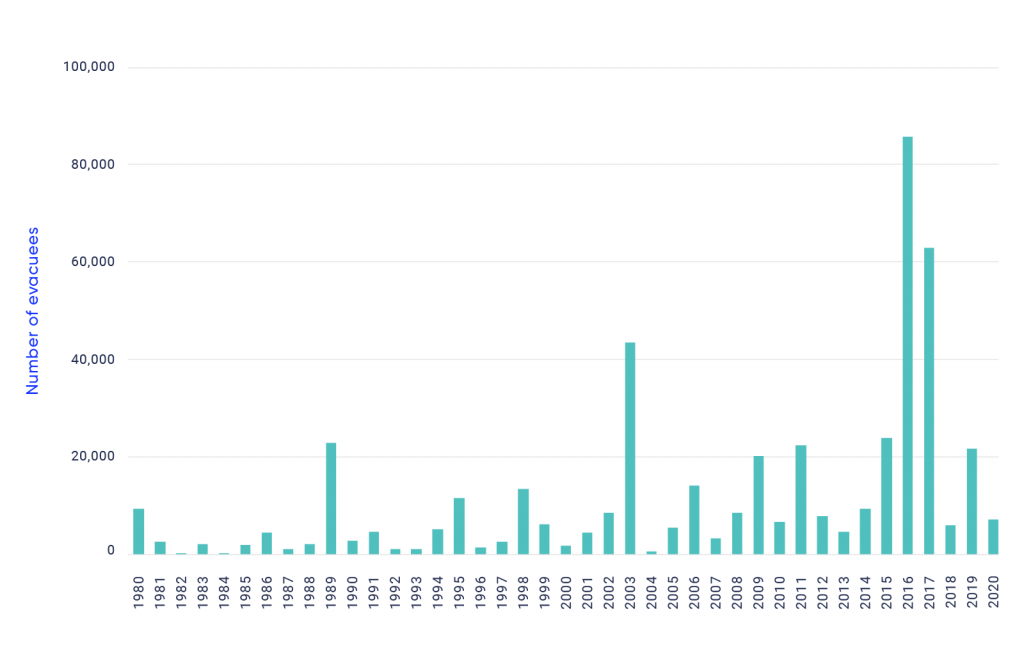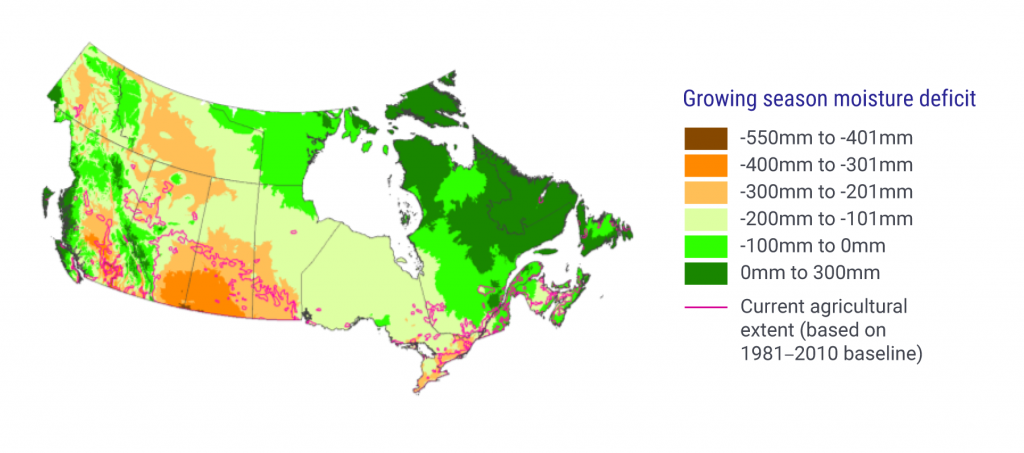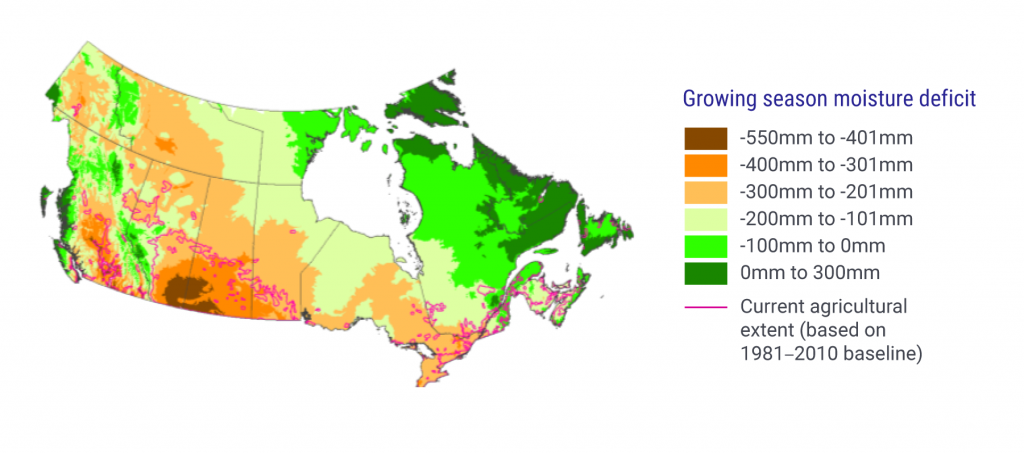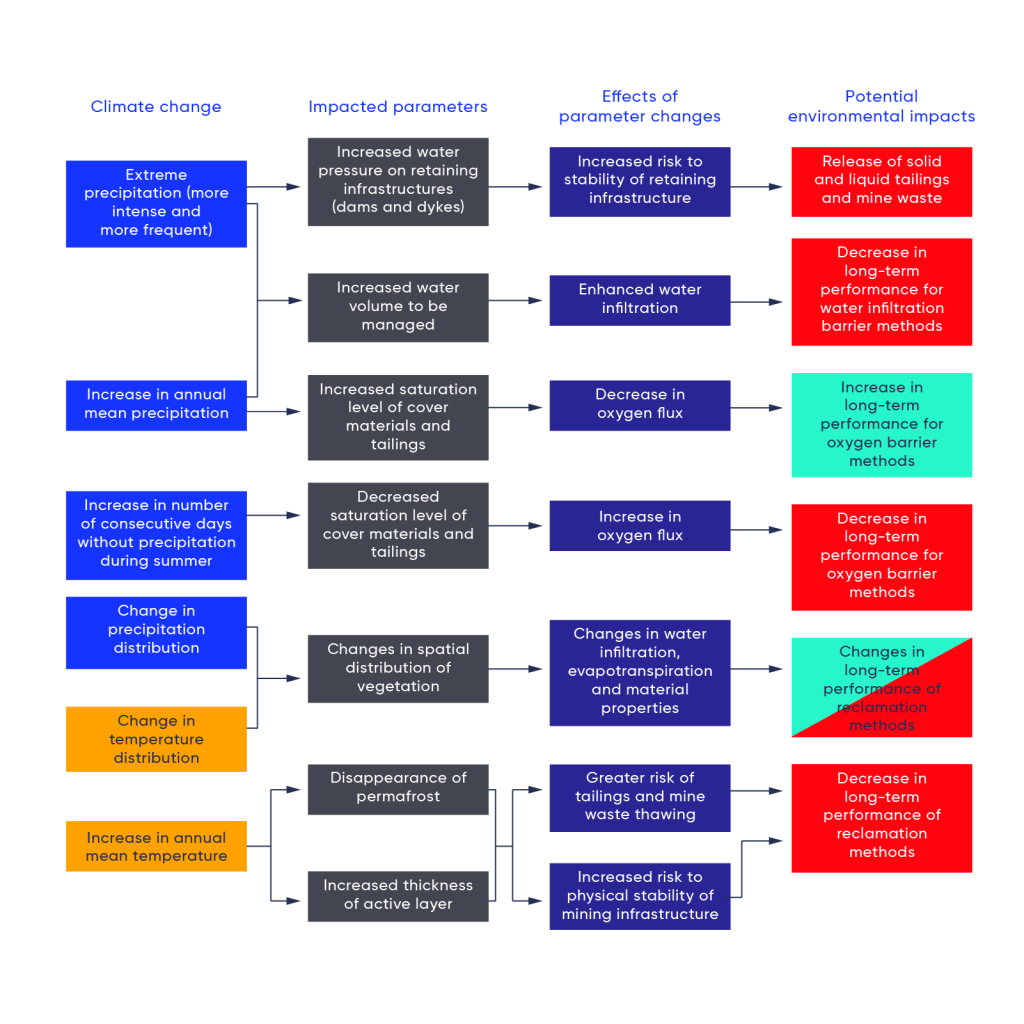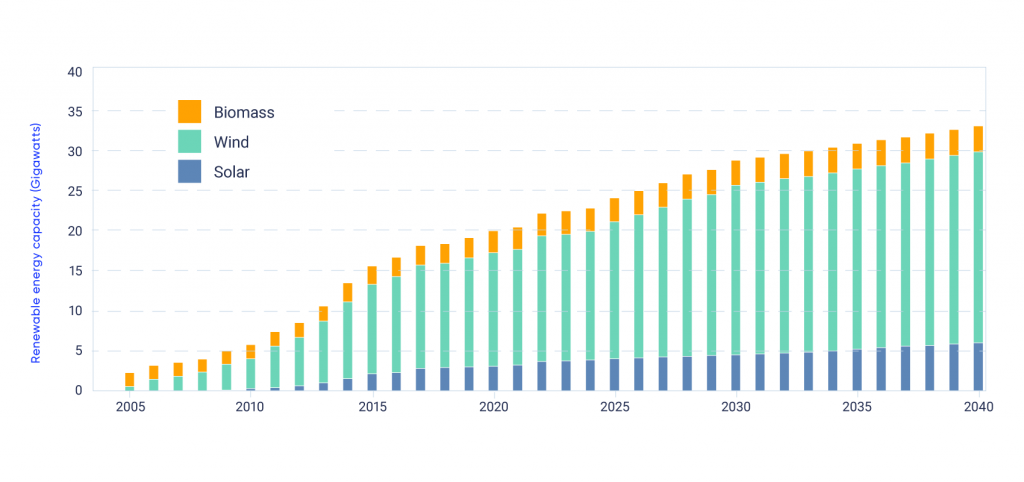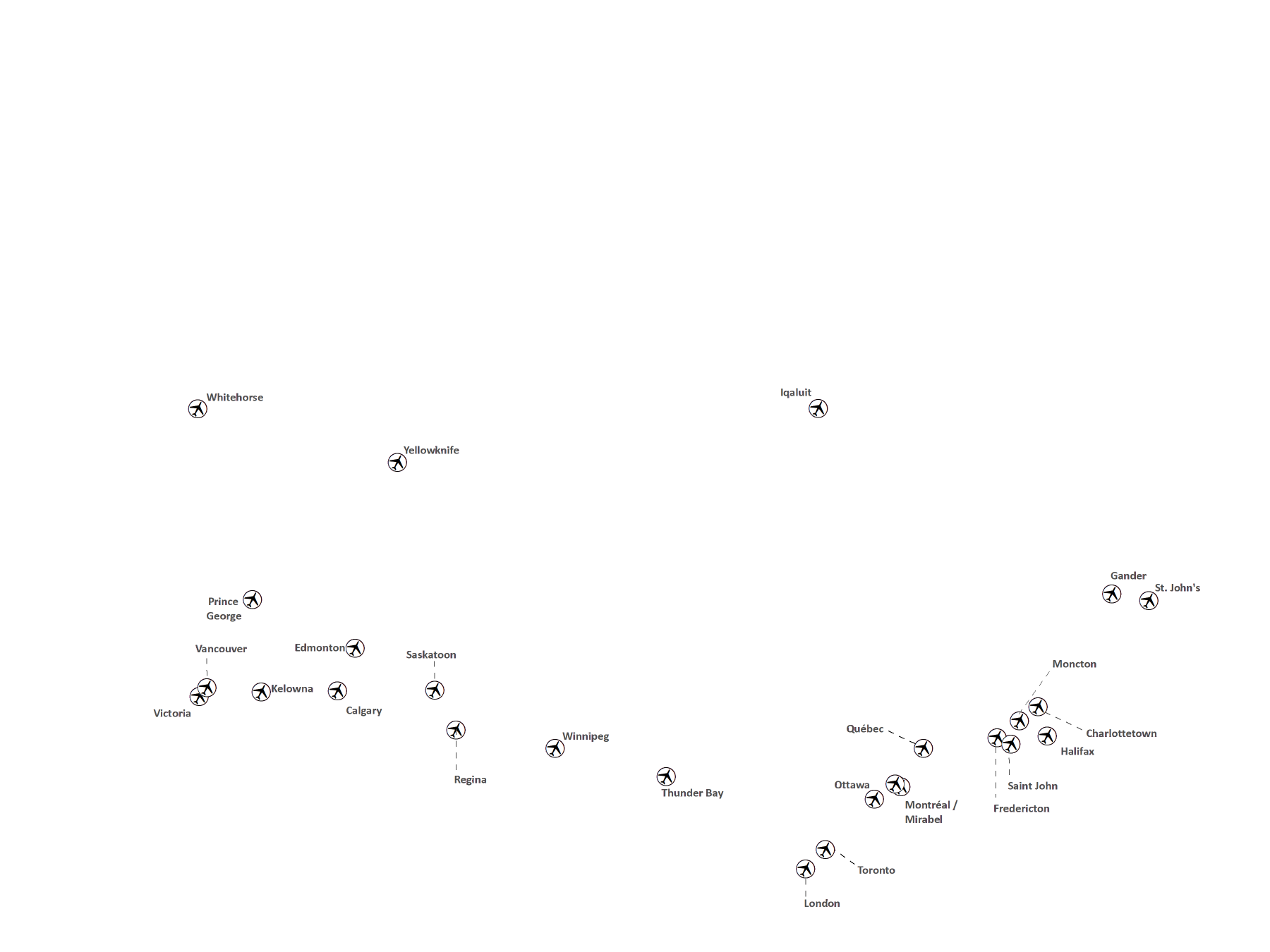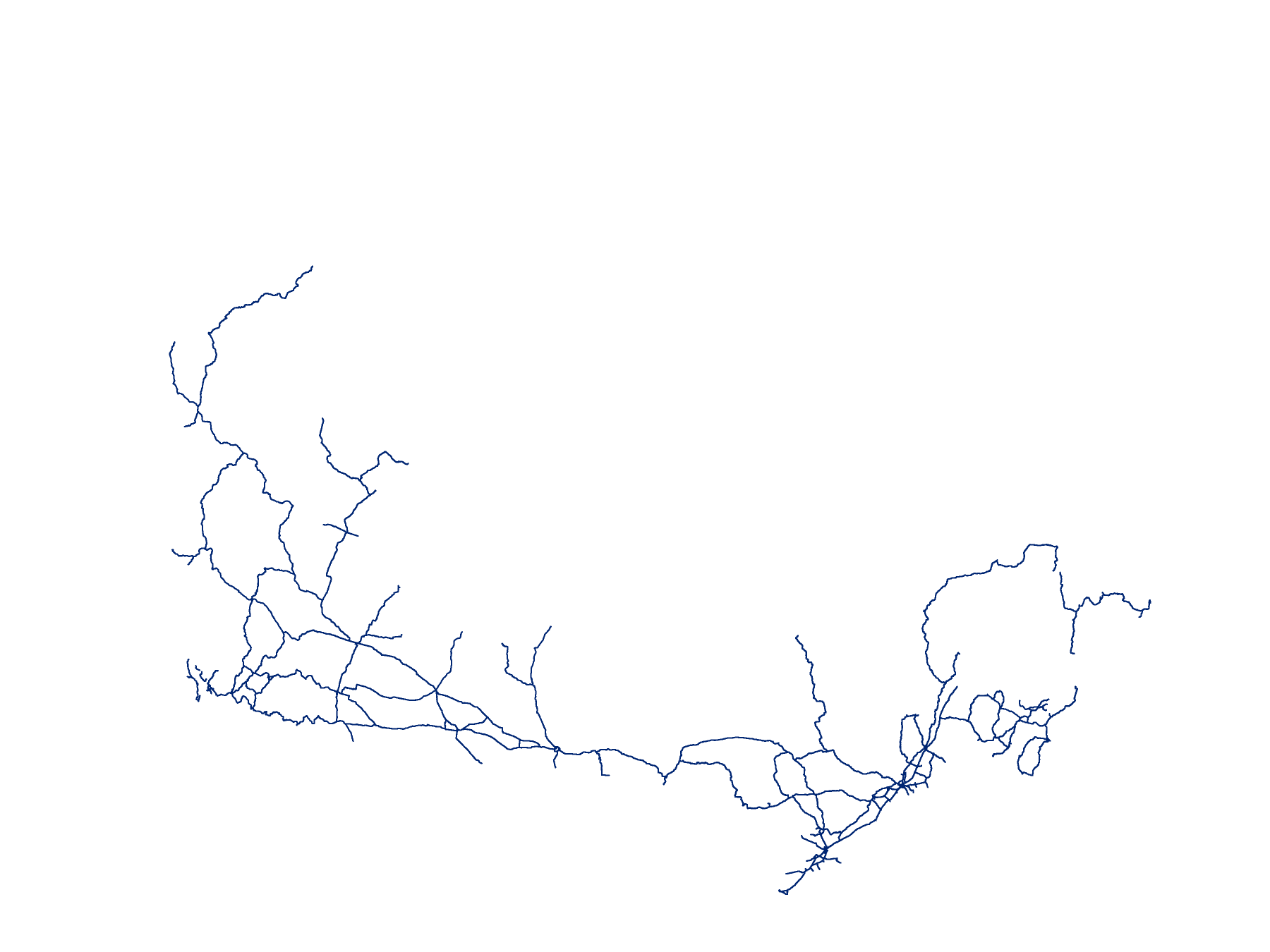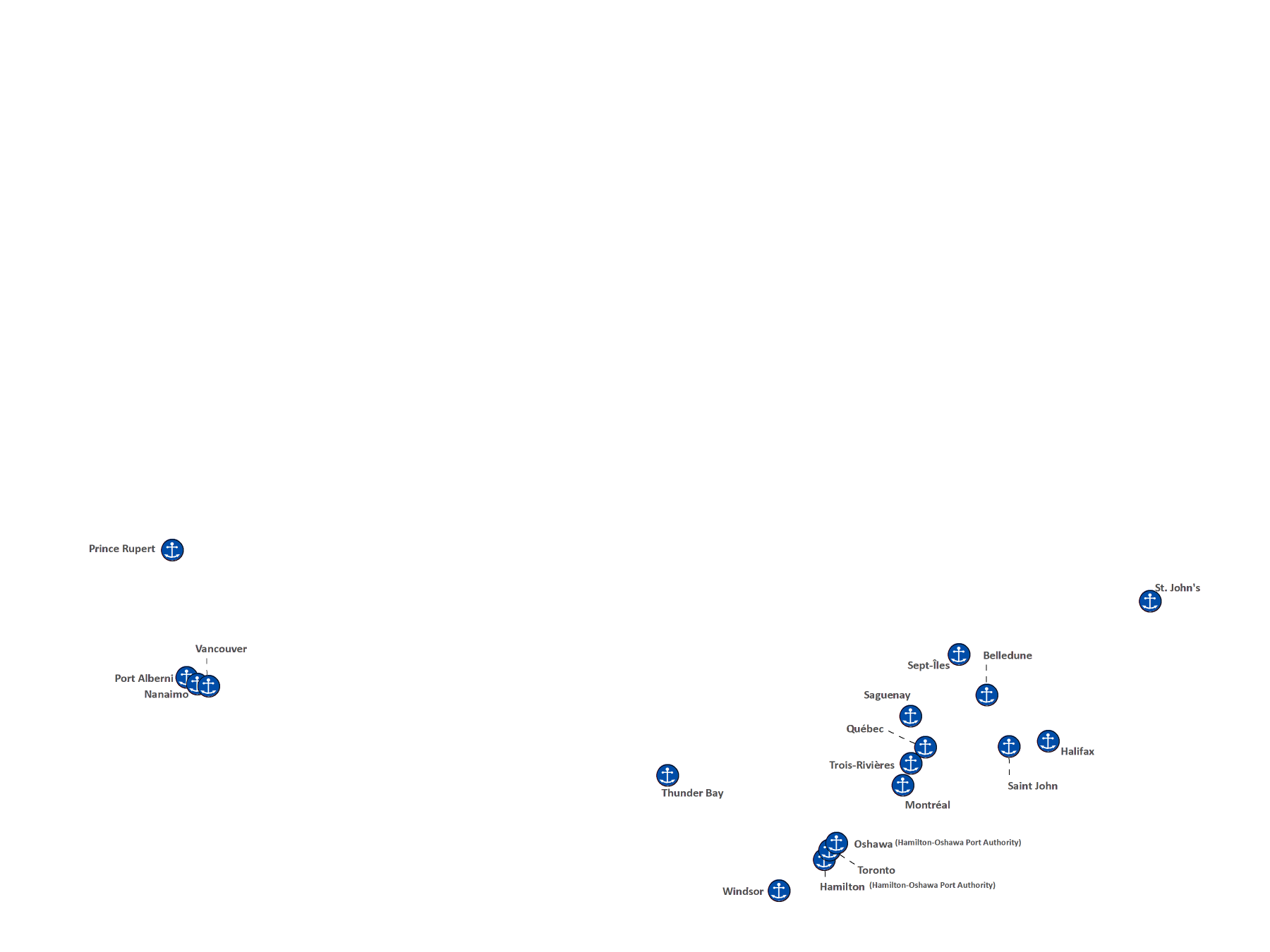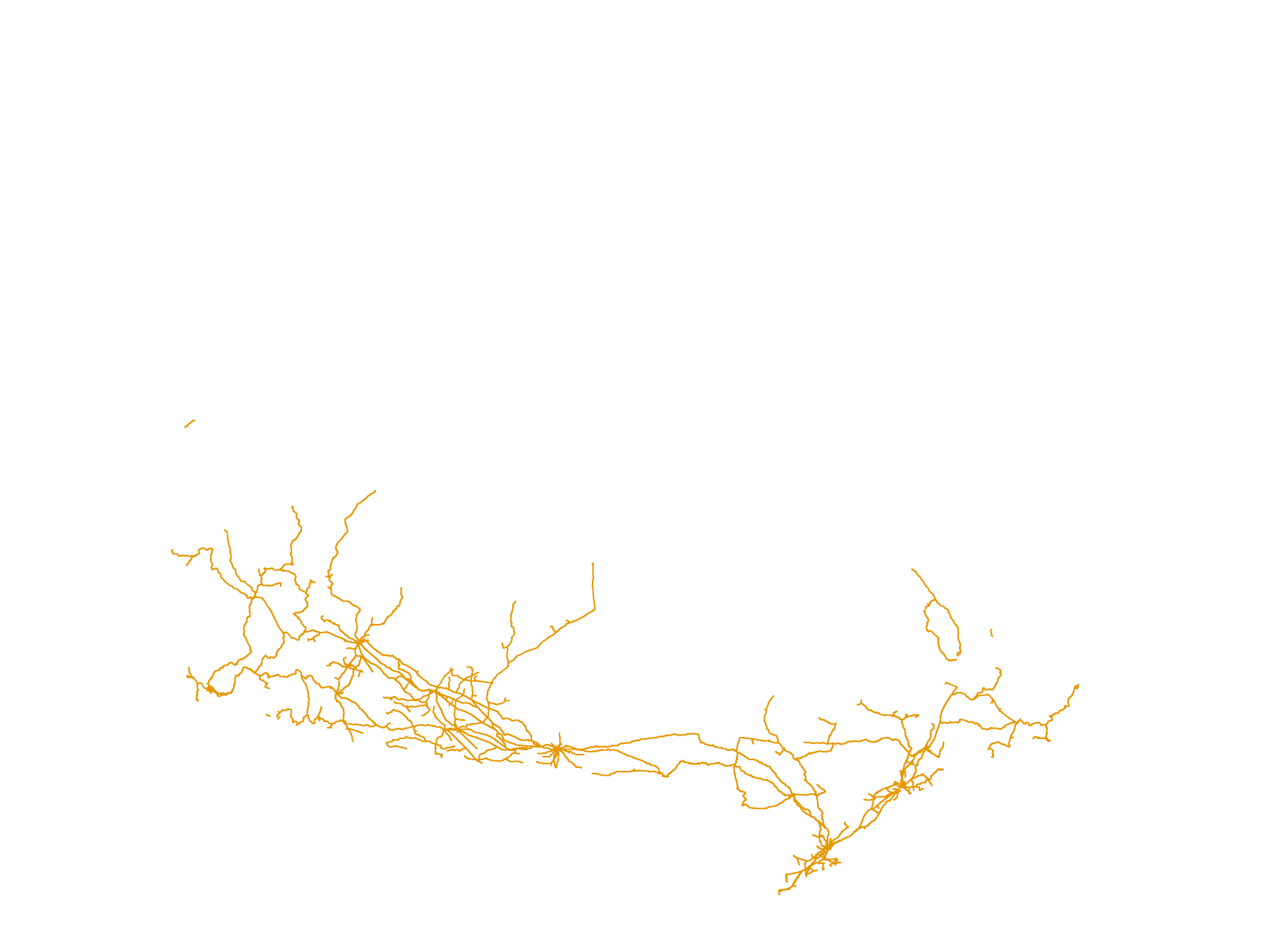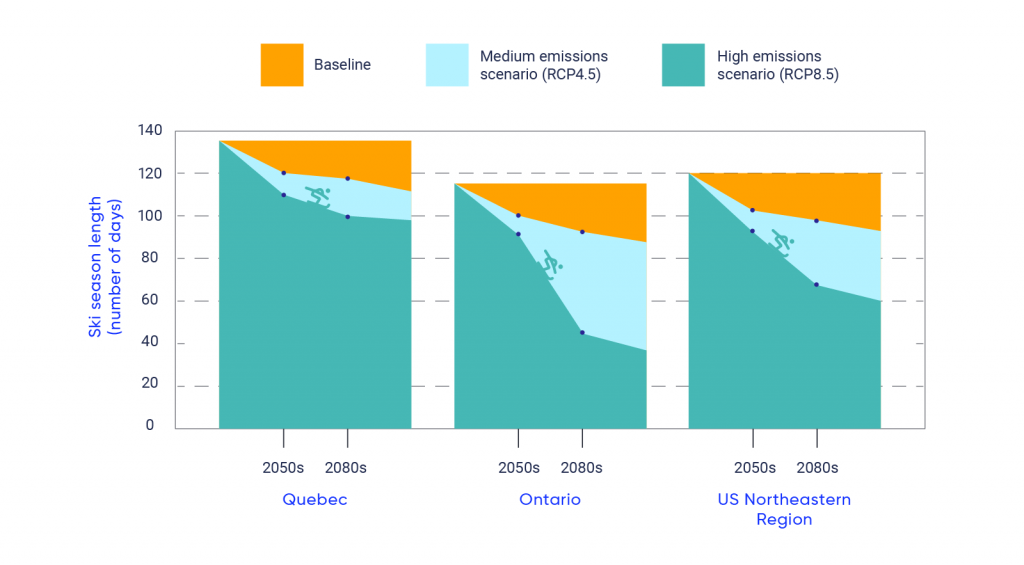Adams, C.F., Alade, L.A., Legault, C.M., O’Brien, L., Palmer, M.C., Sosebee, K.A. and Traver, M.L. (2018). Relative importance of population size, fishing pressure and temperature on the spatial distribution of nine Northwest Atlantic groundfish stocks; PLoS ONE, 13(4), e0196583. Retrieved June 2020, from <https://doi.org/10.1371/journal.pone.0196583>
Agrawala, S., Carraro, M., Kingsmill, N., Lanzi, E., Mullan, M. and Prudent-Richard, G. (2011). Private Sector Engagement in Adaptation to Climate Change. OECD Environment Working Papers 39, OECD Publishing. Retrieved June 2020, from <https://doi.org/10.1787/5kg221jkf1g7-en>
Agriculture Adaptation Working Group (2016). Barriers to Adaptation. Analytic Paper Series Paper #2, Developed under Canada’s Climate Change Adaptation Platform.
Agriculture and Agri-Food Canada (2016). An Overview of the Canadian Agriculture and Agri-Food System 2016. Retrieved June 2020, from <http://www.agr.gc.ca/eng/about-us/publications/economic-publications/an-overview-of-the-canadian-agriculture-and-agri-food-system-2016/?id=1462288050282>
Agriculture and Agri-Food Canada (2018). Climate change scenario maps drawn from CMIP5 data -26 GCMs as supplied by PCIC. Retrieved June 2020, from <https://www.pacificclimate.org/data/statistically-downscaled-climate-scenarios>
Agriculture and Agri-Food Canada (2019). Drought Watch. Retrieved June 2020, from <http://www.agr.gc.ca/eng/programs-and-services/drought-watch/?id=1461263317515>
Agriculture and Agri-Food Canada and Canadian Food Inspection Agency (2008). Invasive Alien Species (IAS) Backgrounder; Agriculture and Agri-Food Portfolio, Environmental Health Research Branch, AAFC and Plant Health Division, Policy and Programs Branch, CFIA.
Alin, S., Evans, W., Gao, Z., Gurney-Smith, H., Lee, K. and Tischenko, P. (2019). Ocean acidification and deoxygenation in the North Pacific Ocean, (Eds.) J. Christian and T. Ono, PICES Special Publication 6, 116 p. Retrieved June 2020, from <https://meetings.pices.int/publications/special-publications/Special-Report%205-Ocean_Acidification.pdf>
Allen, R., Whelen, M. and Khan, A. (2016). Building Resilience to Counter the Impact of International Supply Chain Vulnerabilities. Canadian Transportation Research Forum, 8 p. Retrieved June 2020, from <https://ctrf.ca/wp-content/uploads/2016/05/CTRF2016AllenWhelenKhanLogisticsTrade.pdf>
Amec Foster Wheeler Environment Infrastructure (2017). Canada’s Climate Change Adaptation Platform: Infrastructure and Buildings Working Group Adaptation State of Play Report, 162 p.
American Council on Renewable Energy (2018). The role of Renewable Energy in National Security. Retrieved June 2020, from <https://acore.org/wp-content/uploads/2018/10/ACORE_Issue-Brief_-The-Role-of-Renewable-Energy-in-National-Security.pdf>
Andersland, O.B. and Ladanyi, B. (2003). Frozen ground engineering. John Wiley and Sons, 384 p.
Andrews-Key, S.A. (2018). Vulnerability and Adaptation to Climate Change in Sustainable Forest Management and the Forest Industry in Saskatchewan (PhD Thesis). University of Saskatchewan. Retrieved June 2020, from <http://hdl.handle.net/10388/11671>
Andrey, J. and Palko, K. (2017). Introduction, in Climate risks and adaptation practices for the Canadian transportation sector 2016, (Eds.) K. Palko and D.S. Lemmen. Government of Canada, Ottawa, 2–10. Retrieved June 2020, from <https://www.nrcan.gc.ca/sites/www.nrcan.gc.ca/files/earthsciences/pdf/assess/2016/Chapter-1e.pdf>
Antunes, P., Bernard, M.-C. and Owusu, P. (2016). The Economic Impacts of the 2016 Alberta Wildfires. The Conference Board of Canada, Ottawa. Retrieved June 2020, from <https://www.conferenceboard.ca/e-library/abstract.aspx?did=8420&AspxAutoDetectCookieSupport=1>
Arzhanov, M.M., and Mokhov, I.I. (2013). Temperature trends in the permafrost of the Northern Hemisphere: Comparison of model calculations with observations. Doklady Earth Sciences, 449(1), 319–323. Retrieved June 2020, from <10.1134/S1028334X1303001X>
Astrup, R., Bernier, P.Y., Genet, H., Lutz, D.A. and Bright, R.M. (2018). A sensible climate solution for the boreal forest. Nature Climate Change, 8, 11–12. Retrieved June 2020, from <https://doi.org/10.1038/s41558-017-0043-3>
Asian Development Bank (2012). Climate Risk and Adaptation in the Electric Power Sector. Retrieved June 2020, from <https://www.adb.org/sites/default/files/publication/29889/climate-risks-adaptation-power-sector.pdf>
Asian Development Bank (2013). Guidelines for Climate Proofing Investment in the Energy Sector. Retrieved June 2020, from <https://www.adb.org/documents/guidelines-climate-proofing-investment-energy-sector>
Associated Engineering Limited (2018). Final Report: Improving Coastal Flood Adaptation Approaches. FCM MCIP 15274. Retrieved June 2020, from <https://www.surrey.ca/files/CFAS-ICFAA-FinalReport-29032018.pdf>
Association des Stations de Ski du Québec (2016). Congrès 2016: Le Québec a atteint le 5,125 millions de jours/ski pour la saison 2015-2016. Tourismexpress. Retrieved June 2020, from <https://tourismexpress.com/nouvelles/congres-assq-2016-le-quebec-a-atteint-le-5-125-millions-de-jours-ski-pour-la-saison-2015-16>
Aubertin, M., Bussière, B. and Bernier, L. (2002). Environnement et gestion des résidus miniers. Presses Internationales de Polytechnique, Corporation de l’École Polytechnique de Montréal, Montréal, Canada.
Aubertin, M., Bussière, B., Barbera, J.M., Chapuis, R.P., Monzon, M. and Aachib, M. (1997). Construction and instrumentation of in situ test plots to evaluate covers built with clean tailings. 4th International Conference on Acid Rock Drainage, Vancouver, British Columbia, Canada, vol. 2, 715–730.
Aubertin, M., Bussière, B., James, M., Jaouhar, E.M., Martin, V., Pépin, N., Mbonimpa, M. and Chapuis, R.P. (2011). Vers une mise à jour des critères de stabilité géotechnique pour la conception des ouvrages de retenue de résidus miniers. Symposium 2011 sur l’environnement et les mines, Rouyn-Noranda, Québec, Canada.
Aubertin, M., Bussière, B., Pabst, T., James, M. and Mbonimpa, M. (2016). Review of the reclamation techniques for acid-generating mine wastes upon closure of disposal sites. Geo-Chicago 2016, 343–358. Retrieved June 2020, from <https://ascelibrary.org/doi/10.1061/9780784480137.034>
Aubertin, M., Pabst, T., Bussière, B., James, M., Mbonimpa, M. Benzaazoua and Maqsoud, A. (2015). Revue des meilleures pratiques de restauration des sites d’entreposage de rejets miniers générateurs de DMA. Symposium 2015 sur l’environnement et les mines, Rouyn-Noranda, Québec, Canada.
Averchenkova, A., Crick, F., Kocornik-Mina, A., Leck, H. and Surminski, S. (2016). Multinational and large national corporations and climate adaptation: Are we asking the right questions? A review of current knowledge and a new research perspective. Wiley Interdisciplinary Reviews: Climate Change, 7(4), 517–536. Retrieved June 2020, from <https://doi.org/10.1002/wcc.402>
Azam, S. and Li, Q. (2010). Tailings dam failures: a review of the last one hundred years. Geotechnical News, 28(4), 50–54. Retrieved June 2020, from <https://www.semanticscholar.org/paper/Tailings-Dam-Failures%3A-A-Review-of-the-Last-One-Azam-Li/e57ebdac0a801b412cefd42017c2dded29cafd41>
Bansal, P., Kim, A. and Wood, M.O (2017). Hidden in Plain Sight: The Importance of Scale on Organizational Attention to Issues. Academy of Management Review, 43(2). January, amr.2014.0238. Retrieved June 2020, from <https://doi.org/10.5465/amr.2014.0238>
Barton, A., Hales, B., Waldbusser, G., Langdon, C. and Feely, R.A. (2012). The Pacific oyster, Crassostrea gigas, shows negative correlation to naturally elevated carbon dioxide levels: Implications for near-term ocean acidification effects. Limnology and Oceanography, 57(3), 698–710. Retrieved June 2020, from <https://doi.org/10.4319/lo.2012.57.3.0698>
Beardy’s and Okemasis’ Cree Nation (n.d.). Fire. Retrieved January 2019, from <https://bofn9697.com/tag/fire>
Becken, S., Whittlesea, E., Schliephack, J. and Scott, D. (2020). Tourism and climate change: evaluating the extent of policy integration. Journal of Sustainable Tourism, 25(10), 1–18. Retrieved June 2020, from <https://doi.org/10.1080/09669582.2020.1745217>
Becker, A., Ng, A., McEvoy, D. and Mullett, J. (2018). Implications of climate change for shipping: Ports and supply chains. Wiley Interdisciplinary Reviews: Climate Change, 9(2). Retrieved June 2020, from <https://doi.org/10.1002/wcc.508>
Bentz, B.J., Régnière, J., Fettig, C.J., Hansen, E.M., Hayes, J.L., Hicke, J.A., Kelsey, R.G., Negron, J.F. and Seybold, S.J. (2010). Climate change and bark beetles of the western United States and Canada: direct and indirect effects. BioScience, 60(8), 602–613. Retrieved June 2020, from <https://doi.org/10.1525/bio.2010.60.8.6>
Berkhout, F. (2012). Adaptation to Climate Change by Organizations. Wiley Interdisciplinary Reviews: Climate Change, 3(1), 91–106. Retrieved June 2020, from <https://doi.org/10.1002/wcc.154>
Bernier, P.Y., Gauthier, S., Jean, P.-O., Manka, F., Boulanger, Y., Beaudoin, A. and Guindon, L. (2016). Mapping local effects of forest properties on fire risk across Canada. Forests, 7(8), 157. Retrieved June 2020, from <https://doi.org/10.3390/f7080157>
Berry, P., Clarke, K., Fleury, M.D. and Parker, S. (2014). Human health, Chapter 7 in Canada in a Changing Climate: Sector Perspectives on Impacts and Adaptation, (Eds.) F.J. Warren and D.S. Lemmen. Government of Canada, Ottawa, Ontario, 191–232. Retrieved June 2020, from <https://www.nrcan.gc.ca/sites/www.nrcan.gc.ca/files/earthsciences/pdf/assess/2014/pdf/Chapter7-Human-Health_Eng.pdf>
Beverly, J.L. and Bothwell, P. (2011). Wildfire evacuations in Canada 1980–2007. Natural Hazards, 59(1), 571–596. Retrieved June 2020, from <https://doi.org/10.1007/s11069-011-9777-9>
Bindoff, N.L., Cheung, W.W.L., Kairo, J.G., Arístegui, J., Guinder, V.A., Hallberg, R., Hilmi, N., Jiao, N., Karim, M.S., Levin, L., O’Donoghue, S., Purca Cuicapusa, S.R., Rinkevich, B., Suga, T., Tagliabue, A. and Williamson, P. ( 2019). Changing Ocean, Marine Ecosystems, and Dependent Communities, in IPCC Special Report on the Ocean and Cryosphere in a Changing Climate, (Eds.) H.-O. Pörtner, D.C. Roberts, V. Masson-Delmotte, P. Zhai, M. Tignor, E. Poloczanska, K. Mintenbeck, A. Alegría, M. Nicolai, A. Okem, J. Petzold, B. Rama, N.M. Weyer. Retrieved June 2020, from <https://www.ipcc.ch/srocc/chapter/chapter-5/>
Blackwell, B.A., Shrimpton, G., Steele, F., Ohlson, D.W. and Needoba, A. (2008). Development of a Wildfire Risk Management System for British Columbia Transmission Corporation’s Rights-of-Way. Environment Concerns in Rights-of-Way Management 8th International Symposium, 793–801. Retrieved June 2020, from <https://doi.org/10.1016/B978-044453223-7.50085-X>
Bladon, K.D. (2018). Rethinking wildfires and forest watersheds. Science, 359(6379), 1001–1002. Retrieved June 2020, from <https://doi.org/10.1126/science.aar8120>
Blight, G.H. (2010). Geotechnical Engineering for Mine Waste Storage Facilities. Taylor and Francis Group, London, United Kingdom, CRC Press, 652 p.
Blowes, D.W., Ptacek, C.J., Jambor, J.L. and Weisener, C.G. (2003). The geochemistry of acid mine drainage. Treatise on Geochemistry, 9, 149–204. Retrieved June 2020, from <https://doi.org/10.1016/B0-08-043751-6/09137-4>
Boiffin, J. and Munson, A.D. (2013). Three large fire years threaten resilience of closed crown black spruce forests in eastern Canada. Ecosphere, 4(5), 1–20. Retrieved June 2020, from <https://doi.org/10.1890/ES13-00038.1>
Bombardier Recreational Products (2017). Annual Information Form – 23 March 2017 (Fiscal Year Ended 31 January 2017). Retrieved June 2020, from <http://ir.brp.com/phoenix.zhtml?c=251742&p=irol-reportsannual>
Bonsal, B.R., Peters, D.L., Seglenieks, F., Rivera, A. and Berg, A. (2019). Changes in freshwater availability across Canada, Chapter 6 in Canada’s Changing Climate Report, (Eds.) E. Bush and D.S. Lemmen. Government of Canada, Ottawa, Ontario, 261–342. Retrieved June 2020, from <https://changingclimate.ca/CCCR2019/chapter/6-0/>
Boucher, D., Boulanger, Y., Aubin, I., Bernier, P.Y., Beaudoin, A., Guindon, L. and Gauthier, S. (2018). Current and projected cumulative impacts of fire, drought, and insects on timber volumes across Canada. Ecological Applications, 285, 1245–1259. Retrieved June 2020, from <https://doi.org/10.1002/eap.1724>
Boulanger, Y., Gauthier, S. and Burton, P.J. (2014). A refinement of models projecting future Canadian fire regimes using homogeneous fire regime zones. Canadian Journal of Forest Research, 44(4), 365–376. Retrieved June 2020, from <https://doi.org/10.1139/cjfr-2013-0372>
Boulanger, Y., Girardin, M., Bernier, P.Y., Gauthier, S., Beaudoin, A. and Guindon, L. (2017). Changes in mean forest age in Canada’s forests could limit future increases in area burned but compromise potential harvestable conifer volumes. Canadian Journal of Forest Research, 47(6), 755–764. Retrieved June 2020, from <https://doi.org/10.1139/cjfr-2016-0445>
Boyle, J., Cunningham, M. and Dekens, J. (2013). Climate Change Adaptation and Canadian Infrastructure: A review of the literature. International Institute of Sustainable Development Report, 35 p. Retrieved June 2020, from <https://www.iisd.org/pdf/2013/adaptation_can_infrastructure.pdf>
Braun, M. (2016). New Climate Normals for Electricity Demand Forecasting, Case Study prepared for Climate Change Impacts and Adaptation Division, Natural Resources Canada, 10. Retrieved June 2020, from <https://www.ouranos.ca/publication-cientifique/CaseStudy7_EN_final.pdf>
Braun, M. and Fournier, E. (2016): Adaptation Case Studies in the Energy Sector – Overcoming Barriers to Adaptation, Report presented to Climate Change Impacts and Adaptation Division, Natural Resources Canada, 114 p. Retrieved June 2020, from <https://www.ouranos.ca/publication-scientifique/ReportCaseStudies-EN.pdf>
Breitburg, D., Levin, L.A., Oschlies, A., Grégoire, M., Chavez, F.P., Conley, D.J., Garçon, V., Gilbert, D., Gutiérrez, D., Isensee, K., Jacinto, G.S., Limburg, K.E., Montes, I., Naqvi, S.W.A., Pitcher, G.C., Rabalais, N.N., Roman, M.R., Rose, K.A., Seibel, B.A., Telszewski, M., Yasuhara, M. and Zhang, J. (2018). Declining oxygen in the global ocean and coastal waters. Science, 359(6371), eaam7240. Retrieved June 2020, from <http://dx.doi.org/10.1126/science.aam7240>
Bresson, É., Demers, I., Chavaillaz, Y., Roy, P. and Pabst, T. (2018). Effectiveness of oxygen barriers as reclamation methods under climate change: definition of a drought index. Proceedings of the Tailings and Mine Waste 2018 Conference, Keystone, Colorado, USA. Retrieved June 2020, from <ftp://ftp.mern.gouv.qc.ca/Public/Dc/Conferences_Quebec-Mines-2018/Formation_Nouvelles%20exigences_changements%20climatiques/Bresson%20et%20al%202018.pdf>
Brickman, D., Hebert, D. and Wang, Z. (2018). Mechanism for the recent ocean warming events on the Scotian Shelf of Eastern Canada. Continental Shelf Research, 156(15), 11–22. Retrieved June 2020, from <https://doi.org/10.1016/j.csr.2018.01.001>
British Columbia Ministry of Environment and Climate Change Strategy (2019). Preliminary Strategic Climate Risk Assessment for British Columbia, Report prepared for the Government of British Columbia, Victoria, British Columbia. Retrieved June 2020, from <https://www2.gov.bc.ca/gov/content/environment/climate-change/adaptation/risk-assessment>
Brodeur, R., Perry, I., Boldt, J., Flostrand, L., Galbraith, M., King, J., Murphy, J., Sakuma, K. and Thompson, A. (2018). An unusual gelatinous plankton event in the NE Pacific: The Great Pyrosome Bloom of 2017. PICES Press, 26(1), 22–27. Retrieved June 2020, from <https://www.researchgate.net/publication/322665037_An_unusual_gelatinous_plankton_event_in_the_NE_Pacific_The_Great_Pyrosome_Bloom_of_2017>
Brown, C.D. and Johnstone, J.F. (2012). Once burned, twice shy: Repeat fires reduce seed availability and alter substrate constraints on Picea mariana regeneration. Forest Ecology and Management, 266, 34–41. Retrieved June 2020, from <https://doi.org/10.1016/j.foreco.2011.11.006>
Bureau of Transportation Statistics (2018). Border Crossing/Entry Data. Retrieved June 2020, from <https://www.bts.gov/content/border-crossingentry-data>
Burton, P.J. (2010). Striving for sustainability and resilience in the face of unprecedented change: the case of the mountain pine beetle outbreak in British Columbia. Sustainability, 2(8), 2403–2423. Retrieved June 2020, from <https://doi.org/10.3390/su2082403>
Bush, E. and Lemmen, D.S. (Eds.) (2019). Canada’s Changing Climate Report. Government of Canada, Ottawa, Ontario, 444. Retrieved June 2020, from <https://changingclimate.ca/CCCR2019/>
Bussière, B. (2007). Colloquium 2004: Hydrogeotechnical properties of hard rock tailings from metal mines and emerging geoenvironmental disposal approaches. Canadian Geotechnical Journal, 44(9), 1019–1052. Retrieved June 2020, from <https://doi.org/10.1139/T07-040>
Bussière, B., Aubertin, M. and Chapuis, R.P. (2003). The behavior of inclined covers used as oxygen barriers. Canadian Geotechnical Journal, 40(3), 512–535. Retrieved June 2020, from <https://doi.org/10.1139/t03-001>
Bussière, B., Aubertin, M., Zagury, G. J., Potvin, R. and Benzaazoua, M. (2005). Principaux défis et pistes de solution pour la restauration des aires d’entreposage de rejets miniers abandonnées. Symposium 2005 sur l’environnement et les mines. Retrieved June 2020, from <https://www.researchgate.net/publication/267855816_PRINCIPAUX_DEFIS_ET_PISTES_DE_SOLUTION_POUR_LA_RESTAURATION_DES_AIRES_D’ENTREPOSAGE_DE_REJETS_MINIERS_ABANDONNEES>
Bussière, B., Potvin, R., Dagenais, A., Aubertin, M., Maqsoud, A. and Cyr, J. (2009). Restauration du site minier Lorraine, Latulipe, Québec: Résultats de 10 ans de suivi. Déchets – Revue francophone d’écologie industrielle, 1–16. Retrieved June 2020, from <https://doi.org/10.4267/dechets-sciences-techniques.1254>
Bussière, B., Demers, I., Charron, P., Bossé, B., Roy, P., Jébrak, M. and Trépanier, S. (2017). Analyse de risques et de vulnérabilités liés aux changements climatiques pour le secteur minier québécois, 331 p. Retrieved June 2020, from <https://mern.gouv.qc.ca/wp-content/uploads/analyse-changements-climatiques-secteur-minier.pdf>
Calkin, D.E., Cohen, J.D., Finney, M.A. and Thompson, M.P. (2014). How risk management can prevent future wildfire disasters in the wildland-urban interface. Proceedings of the National Academy of Sciences, 111(2), 746–751. Retrieved June 2020, from <https://doi.org/10.1073/pnas.1315088111>
Campbell, I.D., Durant D.G., Hunter, K.L. and Hyatt, K.D. (2014). Food production, Chapter 4 in Canada in a Changing Climate: Sector Perspectives on Impacts and Adaptation, (Eds.) F.J. Warren and D.S. Lemmen. Government of Canada, Ottawa, Ontario, 99–134. Retrieved June 2020, from <https://www.nrcan.gc.ca/sites/www.nrcan.gc.ca/files/earthsciences/pdf/assess/2014/pdf/Chapter4-Food-Production_Eng.pdf>
Canadian Agri-Food Trade Alliance (2020). Agri-Food Exports. Retrieved June 2020, from <http://cafta.org/agri-food-exports/>
Canadian Council of Forest Ministers (n.d.). Climate Change. Retrieved June 2020, from <http://www.ccfm.org/english/coreproducts-cc.asp>
Canadian Electricity Association (2016). Adapting to Climate Change: State of Play and Recommendations for the Electricity Sector in Canada. Retrieved June 2020, from <https://electricity.ca/wp-content/uploads/2016/02/The_Canadian_Electricity_Association_Releases_a_Roadmap_to_Climate_Change_Adaptation_final.pdf>
Canadian Dam Association (2013). Dam Safety Guidelines. Library and Archives Canada Cataloguing in Publication Data, Ottawa, Ontario.
Centre d’expertise hydrique du Québec (2019). Ministère de l’Environnement et de la Lutte contre les changements climatiques. Retrieved May 2019, from <www.cehq.gouv.qc.ca>
Certified Professional Accountants Canada (2016a). How Organizations Can Adapt to Climate Change. Chartered Professional Accountants Canada. Retrieved June 2020, from <https://www.cpacanada.ca/-/media/site/business-and-accounting-resources/docs/climate-change-mitigation-adaptation-brief-2-how-organizations-can-adapt-to-climate-change-february-2016.pdf?la=en&hash=53D86B64BA875656F49B457BD7CCFB5D4B94859F>
Certified Professional Accountants Canada (2016b). Adaptation Case Study #4: The Co-Operators. Chartered Professional Accountants Canada. <https://www.cpacanada.ca/-/media/site/business-and-accounting-resources/docs/climate-change-adaptation-case-study-4-the-co-operators-october-2015.pdf?la=en&hash=6A57F3569EF436E13C7E2BB0DA6184D7BE4EDF6B>
Chandler, P.C., King, S.A. and Perry, R.I. (Eds.) (2016). State of the physical, biological and selected fishery resources of Pacific Canadian marine ecosystems in 2015. Canadian Technical Report on Fisheries and Aquatic Sciences, 3179, viii + 230 p. Retrieved June 2020, from <https://waves-vagues.dfo-mpo.gc.ca/Library/365564.pdf>
Christianson, A. (2015). Social science research on Indigenous wildfire management in the 21st century and future research needs. International Journal of Wildland Fire, 24(2), 190–200. Retrieved June 2020, from <https://doi.org/10.1071/WF13048>
Ciais, P., Sabine, C., Bala, G., Bopp, L., Brovkin, V., Canadell, J., Chhabra, A., DeFries, R., Galloway, J., Heimann, M., Jones, C., Le Quéré, C., Myneni, R.B., Piao, S. and Thornton, P. (2013). Carbon and Other Biogeochemical Cycles, in Climate Change 2013: The Physical Science Basis (Contribution of Working Group I to the Fifth Assessment Report of the Intergovernmental Panel on Climate Change), (Eds.) T.F. Stocker, D. Qin, G.-K. Plattner, M. Tignor, S.K. Allen, J. Boschung, A. Nauels, Y. Xia, V. Bex and P.M. Midgley. Cambridge University Press, Cambridge, United Kingdom and New York, New York, USA. Retrieved June 2020, from <https://www.ipcc.ch/site/assets/uploads/2018/02/WG1AR5_Chapter06_FINAL.pdf>
Circle of Blue (2018). Stranded Assets. Retrieved June 2020, from <https://www.circleofblue.org/stranded-assets>
City of Surrey (2018). CFAS Primer Part 1: Coastal Flooding in Surrey. Retrieved June 2020, from <http://www.surrey.ca/files/CFAS-Primerpart1.pdf>
Claireaux, G. and Chabot, D. (2016). Responses by fishes to environmental hypoxia: integration through Fry’s concept of aerobic metabolic scope. Journal of Fish Biology, 88, 232–251. Retrieved June 2020, from <https://doi.org/10.1111/jfb.12833>
Coulombe, S., Bernier, P.Y. and Raulier, F. (2010). Uncertainty in detecting climate change impact on the projected yield of black spruce (Picea mariana). Forest Ecology and Management, 259(4), 730–738. Retrieved June 2020, from <https://doi.org/10.1016/j.foreco.2009.06.028>
Council of Canadian Academies (2019). Canada’s Top Climate Change Risks. The Expert Panel on Climate Change Risks and Adaptation Potential, Council of Canadian Academies, Ottawa, Ontario, 70 p. Retrieved June 2020, from <https://cca-reports.ca/wp-content/uploads/2019/07/Report-Canada-top-climate-change-risks.pdf>
Creed, I., Weber, M., Accatino, F. and Kreutzweiser, D. (2016). Managing forests for water in the Anthropocene—the best kept secret services of forest ecosystems. Forests, 7(3), 60. Retrieved June 2020, from <https://doi.org/10.3390/f7030060>
Cross Dependency Initiative (2019). Building climate resilience across critical infrastructure, 4 p. Retrieved June 2020, from <https://xdi.systems/wp-content/uploads/2019/05/XDI_Sydney-A3toA4__singlepages.pdf>
Crossin, G.T., Al-Ayoub, S.A., Jury, S.H., Howell, W.H. and Watson III, W.H. (1998) Behavioral thermoregulation in the American lobster Homarus americanus. Journal of Experimental Biology, 201, 365–374. Retrieved June 2020, from <https://jeb.biologists.org/content/jexbio/201/3/365.full.pdf>
Cruz, A.M. and Krausmann, E. (2013). Vulnerability of the oil and gas sector to climate change and extreme weather events. Climatic Change, 121(1), 41–53. Retrieved June 2020, from <https://link.springer.com/article/10.1007/s10584-013-0891-4>
CTV (2018). All aboard: First passenger train in 18 months departs for Churchill, Man. Retrieved June 2020, from <https://www.ctvnews.ca/mobile/canada/all-aboard-first-passenger-train-in-18-months-departs-for-churchill-man-1.4201440>
Da Silva, L., Desrochers, F.-A., Pineault, K., Gosselin, C.-A., Grenier, P. and Larose, G. (2019). Analyse économique des mesures d’adaptation aux changements climatiques appliquée au secteur du ski alpin au Québec. Ouranos, Montréal, 119 p. Retrieved June 2020, from <https://www.ouranos.ca/publication-scientifique/RapportDaSilva2019.pdf>
Dagenais, A.-M., Aubertin, M., Bussière, B., Bernier, L. and Cyr, J. (2001). Monitoring at the Lorraine Mine Site: A Follow-Up on the Remediation Plan. National Association of Abandoned Mine Land Programs Annual Conference, August 19–22, Athens, Ohio, 19 p. Retrieved June 2020, from <http://citeseerx.ist.psu.edu/viewdoc/download?doi=10.1.1.492.4689&rep=rep1&type=pdf>
Daniel, C.J., Ter-Mikaelian, M.T., Wotton, B.M., Rayfield, B. and Fortin, M.-J. (2017). Incorporating uncertainty into forest management planning: Timber harvest, wildfire and climate change in the boreal forest. Forest Ecology and Management, 400, 542–554. Retrieved June 2020, from <https://doi.org/10.1016/j.foreco.2017.06.039>
Dawson, J., Stewart, E.J., Lemelin, R.H. and Scott, D. (2010). The carbon cost of polar bear viewing tourism in Churchill, Canada. Journal of Sustainable Tourism, 18(3), 319–336. Retrieved June 2020, from <https://doi.org/10.1080/09669580903215147>
Dawson, J., Stewart, E.J., Johnston, M.E. and Lemieux, C.J. (2016). Identifying and evaluating adaptation strategies for cruise tourism in Arctic Canada. Journal of Sustainable Tourism, 24(10), 1425–1441. Retrieved June 2020, from <https://doi.org/10.1080/09669582.2015.1125358>
Dawson, J., Copland, L., Johnston, M.E., Pizzolato, L., Howell, S., Pelot, R., Etienne, L., Matthews, L. and Parsons, J. (2017). Climate change adaptation strategies and policy options for Arctic shipping, Report prepared for Transport Canada. Retrieved June 2020, from <https://ruor.uottawa.ca/handle/10393/36016>
Dawson, J., Pizzolato. L., Howell, S., Copland, L. and Johnston, M. (2018). Temporal and spatial patterns of ship traffic in the Canadian Arctic from 1990 to 2015. Arctic, 71(1), 15–26. Retrieved June 2020, from <https://doi.org/10.14430/arctic4698>
Dawson, R. (2015). Handling interdependencies in climate change risk assessment. Climate, 3(4), 1079–1096. Retrieved June 2020, from <https://doi.org/10.3390/cli3041079>
Department of Environment, Food and Rural Affairs (2011). Climate Resilient Infrastructure: Preparing for a Changing Climate, 71 p. Retrieved June 2020, from <https://www.gov.uk/government/uploads/system/uploads/attachment_data/file/69269/climate-resilient-infrastructure-full.pdf>
Derksen, C., Burgess, D., Duguay, C., Howell, S., Mudryk, L., Smith, S., Thackeray, C. and Kirchmeier-Young, M. (2019). Changes in snow, ice, and permafrost across Canada, Chapter 5 in Canada’s Changing Climate Report, (Eds.) E. Bush and D. S. Lemmen. Government of Canada, Ottawa, Ontario, 194–260. Retrieved June 2020, from <https://changingclimate.ca/CCCR2019/chapter/5-0/>
Dewar, J.A. and Wachs, M. (2008). Transportation planning, climate change, and decision making under uncertainty. Transportation Research Board, 26 p. Retrieved June 2020, from <http://onlinepubs.trb.org/onlinepubs/sr/sr290dewarwachs.pdf>
Dixon, L., Tsang, F. and Fitts, G. (2018). The Impact of Changing Wildfire Risk on California’s Residential Insurance Market. The RAND Corporation, California, USA, 105 p. Retrieved June 2020, from <http://climateassessment.ca.gov/techreports/docs/20180827-Forests_CCCA4-CNRA-2018-008.pdf>
Doré, G. and Zubeck, H. K. (2009). Cold regions pavement engineering. ASCE Press, Reston, Virginia, 403 p.
Dougherty-Choux, L., Terpstra, P., Kamila, S. and Kurukulasuriya, P. (2015). Adapting from the Ground Up. World Resources Institute, Washington, DC. Retrieved June 2020, from <https://www.preventionweb.net/go/47027>
Downing, T.E. (2012). Views of the frontiers in climate change Adaptation economics. Wiley Interdisciplinary Reviews: Climate Change, 3(2), 161–70. Retrieved June 2020, from <https://doi.org/10.1002/wcc.157>
Dubois, A., Hulthen, K. and Pedersen, A. (2011). Interdependence Within and Among “Supply Chains”. 21 p. Retrieved June 2020, from <https://www.researchgate.net/profile/Kajsa_Hulthen/publication/242489338_INTERDEPENDENCE_WITHIN_AND_AMONG_aposSUPPLY_CHAINSapos/links/54006e0c0cf24c81027dec7e/INTERDEPENDENCE-WITHIN-AND-AMONG-aposSUPPLY-CHAINS-apos.pdf>
Dupont-Prinet, A., Vagner, M., Chabot, D. and Audet, C. (2013). Impact of hypoxia on the metabolism of Greenland halibut (Reinhardtius hippoglossoides). Canadian Journal of Fisheries and Aquatic Sciences, 70, 461–469. Retrieved June 2020, from <https://doi.org/10.1139/cjfas-2012-0327>
Dymond, C.C., Spittlehouse, D.L., Tedder, S., Hopkins, K., McCallion, K. and Sandland, J. (2015). Applying resilience concepts in forest management: a retrospective simulation approach. Forests, 6(12), 4421–4438. Retrieved June 2020, from <https://doi.org/10.3390/f6124377>
Earnscliffe Strategy Group (2018). National Climate Change Adaptation Survey, Report prepared for Climate Change Impacts and Adaptation Division, Natural Resources Canada, Ottawa.
Edwards, J.E., Pearce, C., Ogden, A.E. and Williamson, T.B. (2015). Climate change and sustainable forest management in Canada: a guidebook for assessing vulnerability and mainstreaming adaptation into decision making. Canadian Council of Forest Ministers, Climate Change Task Force, 172 p. Retrieved June 2020, from <https://www.ccfm.org/pdf/Vulnerability%20Guidebook_June2_EN.pdf>
Ekstrom, J.A., Suatoni, L., Cooley, S.R., Pendelton, L.H., Waldbusser, G.G., Cinner, J.E., Ritter, J., Langdon, C., van Hooidonk, R., Gledhill, D., Wellman, K., Beck, M.W., Brander, L.M., Rittschof, D., Doherty, C., Edwards, P.E.T. and Portela, R. (2015). Vulnerability and adaptation of US shellfisheries to ocean acidification. Nature Climate Change, 5, 207–214. Retrieved June 2020, from <https://doi.org/10.1038/nclimate2508>
Environment and Climate Change Canada (2018). Canadian Centre for Climate Services. Retrieved December 2019, from <https://www.canada.ca/en/environment-climate-change/services/climate-change/canadian-centre-climate-services.html>
Environment and Climate Change Canada (2020). Strategic assessment of climate change (revised October 2020), 20 p. Retrieved October 2020, from <https://www.canada.ca/en/services/environment/conservation/assessments/strategic-assessments/climate-change.html>
Eriksson, N. and Adamek, P. (2000). The tailings pond failure at the Aznalcóllar mine, Spain. British Columbia MEND ML/ARD Annual Workshop, 8 p. Retrieved June 2020, from <http://bc-mlard.ca/files/presentations/2016-19-ERIKSSON-ADAMEK-tailings-pond-failure-aznalcollar.pdf>
Ernst, B., Orensanz, J.M. and Armstrong, D.A. (2005). Spatial dynamics of female snow crab (Chionoecetes opilio) in the eastern Bering Sea. Canadian Journal of Fisheries and Aquatic Sciences, 62, 250–268. Retrieved June 2020, from <https://doi.org/10.1139/f04-201>
Ethier, M.P., Bussière, B., Broda, S. and Aubertin, M. (2018). Three-dimensional hydrogeological modeling to assess the elevated-water-table technique for controlling acid generation from an abandoned tailings site in Quebec, Canada. Hydrogeology Journal, 26(4), 1201–1219. Retrieved June 2020, from <https://doi.org/10.1007/s10040-017-1713-y>
Executive Office of the President (2013). Economic benefits of increasing electric grid resilience to weather outages. Retrieved June 2020, from <http://energy.gov/ sites/prod/files/2013/08/f2/Grid%20Resiliency%20 Report_FINAL.pdf>
Eyzaguirre, J. and Warren, F.J. (2014). Adaptation: Linking research and practice, Chapter 9 in Canada in a Changing Climate: Sector Perspectives on Impacts and Adaptation, (Eds.) F.J. Warren and D. S. Lemmen. Government of Canada, Ottawa, Ontario, 253–286. Retrieved June 2020, from <https://www.nrcan.gc.ca/sites/www.nrcan.gc.ca/files/earthsciences/pdf/assess/2014/pdf/Chapter9-Adaptation_Eng.pdf>
Eyzaguirre, J. (2016). FAQ 11: How do the costs of climate change impacts compare to the costs of adaptation?, in Canada’s Marine Coasts in a Changing Climate, (Eds.) D.S. Lemmen, F.J. Warren, T.S. James and C.S.L. Mercer Clarke. Government of Canada, Ottawa, Ontario, 270‒272. Retrieved June 2020, from <https://www.nrcan.gc.ca/sites/www.nrcan.gc.ca/files/earthsciences/pdf/assess/2016/Coastal_Assessment_Chapter7_FrequentlyAskedQuestions.pdf>
Federal, Provincial and Territorial Emergency Management Framework Task Team. (2016). Emergency Management Framework for Agriculture in Canada; Agriculture and Agri-Food Canada, 22 p. Retrieved June 2020, from <http://www.agr.gc.ca/resources/prod/doc/pdf/emf-gu_2016-eng.pdf>
Finlay, S.E., Moffat, A., Gazzard, R., Baker, D. and Murray, V. (2012). Health impacts of wildfires. PLoS Currents Disasters, Edition 1. Retrieved June 2020, from <https://doi.org/10.1371/4f959951cce2c>
Finley, T. and Schuchard, R. (n.d.). Adapting to climate change: a guide for the transportation industry. BSR Industry Series, 7 p. Retrieved June 2020, from <https://www.bsr.org/reports/BSR_Climate_Adaptation_Issue_Brief_Transportation.pdf>
FireSmart Canada (2018). FireSmart Guidebook for the Oil and Gas Industry. Retrieved June 2020, from <https://www.firesmartcanada.ca/mdocs-posts/firesmart-guidebook-for-the-oil-and-gas-industry>
FireSmart Canada (2019a). FireSmart Videos. Retrieved June 2020, from <https://www.firesmartcanada.ca/resources-library/firesmart-videos>
FireSmart Canada (2019b). Vegetation Management. Retrieved June 2020, from <https://www.firesmartcanada.ca/what-is-firesmart/vegetation-management>
Fisheries and Oceans Canada (2018a). Seafisheries: 2016 value of Atlantic Coast commercial landings, by region. Retrieved June 2020, from <http://www.dfo-mpo.gc.ca/stats/commercial/land-debarq/sea-maritimes/s2016av-eng.htm>
Fisheries and Oceans Canada (2018b). Assessment of the Estuary and northern Gulf of St. Lawrence (areas 13 to 17, 12A, 12B, 12C and 16A) snow crab stocks in 2017. DFO Canadian Science Advisory Secretariat Science Advisory Report 2018/047, 30 p. Retrieved June 2020, from <https://waves-vagues.dfo-mpo.gc.ca/Library/40738565.pdf>
Fisheries and Oceans Canada (2018c). Assessment of northern shrimp stocks in the Estuary and Gulf of St. Lawrence in 2017. DFO Canadian Advisory Secretariat Science Advisory Report 2018/015, 17 p. Retrieved June 2020, from <https://waves-vagues.dfo-mpo.gc.ca/Library/40688495.pdf>
Fisheries and Oceans Canada (2018d). Assessment of the Greenland halibut stock in the Gulf of St. Lawrence (4rst) in 2017. DFO Canadian Advisory Secretariat Science Advisory Report 2018/035, 20 p. Retrieved June 2020, from <https://waves-vagues.dfo-mpo.gc.ca/Library/40714007.pdf>
Fisheries and Oceans Canada (2018e). Proceedings on the National Peer Review on Incorporating environmental and climate change considerations into population assessments in DFO’s Science advisory process, May 8–9, 2018. DFO Canadian Scientific Advisory Secretariat.
Flannigan, M.D., Krawchuk, M.A., De Groot, W.J., Wotton, B.M. and Gowman, L.M. (2009). Implications of changing climate for global wildland fire. International Journal of Wildland Fire, 18(5), 483–507. Retrieved June 2020, from <https://doi.org/10.1071/WF08187>
Flannigan, M., Cantin, A.S., De Groot, W.J., Wotton, M., Newbery, A. and Gowman, L.M. (2013). Global wildland fire season severity in the 21st century. Forest Ecology and Management, 294, 54–61. Retrieved June 2020, from <https://doi.org/10.1016/j.foreco.2012.10.022>
Food and Agriculture Organization (2017). The future of food and agriculture: Trends and challenges; Food and Agriculture Organization of the United Nations Rome, 180 p. Retrieved June 2020, from <http://www.fao.org/3/a-i6583e.pdf>
Fournier, É. (2016). Fine-Tuning Observations to Better Manage and Design Hydroelectricity Assets, Case Study prepared for Climate Change Impacts and Adaptation Division, Natural Resources Canada, 9 p. Retrieved June 2020, from <https://www.ouranos.ca/publication-scientifique/CaseStudy2_EN_final.pdf>
Furness, E. and Nelson, H. (2016). Are human values and community participation key to climate adaptation? The case of community forest organisations in British Columbia. Climatic Change, 135(2), 243–259. Retrieved June 2020, from <https://doi.org/10.1007/s10584-015-1564-2>
Furrer, B., Hoffmann, V. and Marion S. (2009). Banking and Climate Change: Opportunities and Risks. SAM (Sustainable Asset Management), Zurich, 51 p. Retrieved June 2020, from <http://www.sustainabilitycompany.it/img/text/SAM_ETH_Study_Banking.pdf>
Fyfe, J., Derksen, C., Mudryk, L., Flate, G.M., Santer, B.D., Swart, N.C., Molotech, N.P., Zhang, X., Wan, H., Arora, V.K., Scinocca, J. and Jiao, Y. (2017). Large near-term projected snowpack loss over the western United States. Nature Communications, 8. Retrieved June 2020, from <https://doi.org/10.1038/ncomms14996>
Galbraith, P.S., Chassé, J., Caverhill, C., Nicot, P., Gilbert, D., Pettigrew, B., Lefaivre, D., Brickman, D., Devine, L., Lafleur, C. (2018). Physical oceanographic conditions in the Gulf of St. Lawrence during 2017. DFO Canadian Science Advisory Secretariat, Research Document 2018/050, v + 79 p. Retrieved June 2020, from <https://waves-vagues.dfo-mpo.gc.ca/Library/40759702.pdf>
Gatin, J. and Johnston, M. (2017). State of Play Report: Forestry Adaptation Initiatives across Canada. Canadian Forestry Service, Natural Resources Canada, Ottawa.
Gauthier, S., Bernier, P. Y., Boulanger, Y., Guo, J., Guindon, L., Beaudoin, A. and Boucher, D. (2015). Vulnerability of timber supply to projected changes in fire regime in Canada’s managed forests. Canadian Journal of Forest Research, 45(11), 1439–1447. Retrieved June 2020, from <https://doi.org/10.1139/cjfr-2015-0079>
Gauthier, S., Bernier, P., Burton, P.J., Edwards, J., Isaac, K., Isabel, N., Jayen, K., Le Goff, H. and Nelson, E.A. (2014). Climate change vulnerability and adaptation in the managed Canadian boreal forest. Environmental Reviews, 22(3), 256–285. Retrieved June 2020, from <https://doi.org/10.1139/er-2013-0064>
Gazeau, F., Parker, L.M., Comeau, S., Gattuso, J.-P., O’Connor, W.A., Martin, S., Pörtner, H.-O. and Ross, P. (2013). Impacts of ocean acidification on marine shelled molluscs. Marine Biology, 160 (8), 2207–2245. Retrieved June 2020, from <https://doi.org/10.1007/s00227-013-2219-3>
Gill, A.M., Stephens, S.L. and Cary, G.J. (2013). The worldwide “wildfire” problem. Ecological Applications, 23(2), 438–454. Retrieved June 2020, from <https://doi.org/10.1890/10-2213.1>
Gledhill, D.K., White, M.M., Salisbury, J., Thomas, H., Mlsna, I., Liebman, M., Mook, B., Grear, J., Candelmo, A.C., Chambers, R.C., Gobler, C.J., Hunt, C.W. King, A.L., Price, N.N., Signorini, S.R., Stancioff, E., Stymiest, C., Wahle R.A., Waller, J.D., Rebuck, N.D., Wang, Z.A., Capson, T.L., Morrison, J.R., Cooley, S.R. and Doney, S.C. (2015). Ocean and Coastal Acidification off New England and Nova Scotia. Oceanography, 28(2), 182–197. Retrieved June 2020, from <https://doi.org/10.5670/oceanog.2015.41>
Globe and Mail (2018). “It’s devastating to see”: How a rail line crisis is threatening Churchill, Manitoba. Retrieved June 2020, from <https://www.theglobeandmail.com/politics/article-churchill-man-residents-angry-and-frustrated-as-solutions-to-rail>
Goertzen, S. (2018). Agricultural Solutions to Climate Change: Findings from the Manitoba Agriculture Climate Initiative. Keystone Agricultural Producers, 30 p. Retrieved June 2020, from <https://486d1ae5-bba6-4d54-8d48-301060955887.filesusr.com/ugd/b43985_b680623ee3504c099fc30c3ccf48d960.pdf>
Goodrick, S.L., Achtemeier, G.L., Larkin, N.K., Liu, Y. and Strand, T.M. (2013). Modelling smoke transport from wildland fires: a review. International Journal of Wildland Fire, 22(1), 83–94. Retrieved June 2020, from <https://doi.org/10.1071/WF11116>
Government of Canada (2016). Pan-Canadian framework on clean growth and climate change: Canada’s plan to address climate change and grow the economy. 77 p. Retrieved June 2020, from <https://www.canada.ca/content/dam/themes/environment/documents/weather1/20170125-en.pdf>
Government of Canada (2020) Wildland fire evacuations, Natural Resources Canada. Retrieved May 2020 from <https://www.nrcan.gc.ca/climate-change/impacts-adaptations/climate-change-impacts-forests/forest-change-indicators/wildland-fire-evacuations/17787>
Gray, R. (2015). The Economic Impacts of Elevated Export Basis Levels on Western Canadian Grain Producers 2012/13, 2013/14, and 2014/15, Report submitted to the Saskatchewan Wheat Development Commission. Retrieved June 2020, from <https://static1.squarespace.com/static/5c40f31a620b85cf0d073e7b/t/5cdd901fc9048b0001f4599d/1558024227090/The-Economic-Impacts-Of-Elevated-Export-Basis-Levels-On-Western-Canadian-Grain-Producers-2012-2015.pdf>
Greenan, B.J.W., James, T.S., Loder, J.W., Pepin, P., Azetsu-Scott, K., Ianson, D., Hamme, R.C., Gilbert, D., Tremblay, J-E., Wang, X.L. and Perrie, W. (2019a). Changes in oceans surrounding Canada, Chapter 7 in Canada’s Changing Climate Report, (Eds.) Bush and Lemmen. Government of Canada, Ottawa, Ontario, 343–423. Retrieved June 2020, from <https://changingclimate.ca/CCCR2019/chapter/7-0/>
Greenan, B.J.W., Shackell, N.L., Ferguson, K., Greyson, P., Cogswell, A., Brickman, D., Wang, Z., Cook, A., Brennan, C.E. and Saba, V.S. (2019b). Climate Change Vulnerability of American Lobster Fishing Communities in Atlantic Canada. Frontiers in Marine Science, 6, 579 p. Retrieved June 2020, from <https://doi.org/10.3389/fmars.2019.00579>
Groulx, M., Lemieux, C., Dawson, J., Stewart, E. and Yudina, O. (2016). Motivations to engage in last chance tourism in the Churchill wildlife management area and Wapusk National Park: The role of place identity and nature relatedness. Journal of Sustainable Tourism, 24(11), 1523–1540. Retrieved June 2020, from <https://doi.org/10.1080/09669582.2015.1134556>
Groulx. M., Lemieux, C.J., Lewis, J.L. and Brown, S. (2017). Understanding consumer behaviour and adaptation planning responses to climate-driven environmental change in Canada’s parks and protected areas: a climate futurescapes approach. Journal of Environmental Planning and Management, 60(6), 1016–1035. Retrieved June 2020, from <https://doi.org/10.1080/09640568.2016.1192024>
Guittonny, M., Bussière, B., Maqsoud, A., Proteau, A., Ben Khouya, T. and Botula, Y.D. (2018). Colonisation racinaire dans les recouvrements miniers et impact sur leur fonctionnement. Proceedings of the 6th Symposium on Mines and the Environment, June 2018, Rouyn-Noranda, Canada.
Guthrie, R.H., Mitchell, S.J., Lanquaye-Opoku, N. and Evans, S. G. (2010). Extreme weather and landslide initiation in coastal British Columbia. Quarterly Journal of Engineering Geology and Hydrogeology, 43(4), 417–428. Retrieved June 2020, from <https://doi.org/10.1144/1470-9236/08-119>
Hanes, C., Wang, X., Jain, P., Parisien, M.-A., Little, J. and Flannigan, M. (2018). Fire regime changes in Canada over the last half century. Canadian Journal of Forest Research, 49(3), 256-269. Retrieved June 2020, from <https://doi.org/10.1139/cjfr-2018-0293>
Hatchett, B. and Eisen, H. (2018). Early season snowpack loss and implications for over-snow vehicle recreation travel planning. The Cryosphere. Retrieved June 2020, from <https://doi.org/10.5194/tc-2018-181>
He, W., Yang, J.Y., Qian, B., Drury, C.F., Hoogenboom G., He, P., Lapen, D. and Zhou, W. (2018). Climate change impacts on crop yield, soil water balance and nitrate leaching in the semiarid and humid regions of Canada. PLoS ONE, 13(11), e0207370. Retrieved June 2020, from <https://doi.org/10.1371/journal.pone.0207370>
Hedlund, J., Fick, S., Carlsen, H. and Benzie, M. (2018). Quantifying transnational climate impact exposure: New perspectives on the global distribution of climate risk. Global Environmental Change, 52, 75-85. Retrieved June 2020, from <https://doi.org/10.1016/j.gloenvcha.2018.04.006>
Henstra, D. and Thistlethwaite, J. (2017). Climate Change, Floods, and Municipal Risk Sharing in Canada. IMFG Papers on Municipal Finance and Governance, No. 30, Institute on Municipal Finance and Governance, Toronto, 48 p. Retrieved June 2020, from <https://munkschool.utoronto.ca/imfg/uploads/373/1917_imfg_no_30_online_final.pdf>
Hewer, M. and Gough, W. (2018). Thirty years of assessing the impacts of climate change on outdoor recreation and tourism in Canada. Tourism Management Perspectives, 26, 179–192. Retrieved June 2020, from <https://doi.org/10.1016/j.tmp.2017.07.003>
Hirsch, K., Kafka, V., Tymstra, C., McAlpine, R., Hawkes, B., Stegehuis, H., Quintilio, S., Gauthier, S. and Peck, K. (2001). Fire-smart forest management: a pragmatic approach to sustainable forest management in fire-dominated ecosystems. The Forestry Chronicle, 77(2), 357–363. Retrieved June 2020, from <https://doi.org/10.5558/tfc77357-2>
Holubec, I. (2004). Covers for Reactive Tailings Located in Permafrost Regions Review. MEND Report 1.61. 6., Minerals and Metals Sector, Natural Resources Canada, Ottawa. Retrieved June 2020, from <http://mend-nedem.org/wp-content/uploads/1.61.4CoversPermafrostRegions.pdf>
Hope, E.S., McKenney, D.W., Pedlar, J.H., Stocks, B.J. and Gauthier, S. (2016). Wildfire suppression costs for Canada under a changing climate. PLoS ONE, 11(8), e0157425. Retrieved June 2020, from <https://doi.org/10.1371/journal.pone.0157425>
Hotton, G., Bresson, É., Bussière, B., Pabst, T., Demers, I. and Roy, P. (2018). Assessment of CCBE performance with climate change: case study of the Lorraine mine site. Proceedings of the Tailings and Mine Waste 2018 Conference, Keystone, Colorado, USA.
Hotton, G., Bussière, B., Pabst, T., Bresson, E. and Roy, P. (2019). Influence of climate change on the ability of a cover with capillary barrier effects to control acid generation. Hydrogeology Journal. Retrieved June 2020, from <https://doi.org/10.1007/s10040-019-02084-y>
Hori, Y., Gough, W.A., Butler, K. and Tsuji, L.J.S. (2017). Trends in the seasonal length and opening dates of a winter road in the western James Bay region, Ontario, Canada. Theoretical and Applied Climatology, 129(3), 1309–1320. Retrieved June 2020, from <https://doi.org/10/gbq6gv>
Hrycik, A.R, Almeida, L.Z. and Höök, T.O. (2017). Sub‐lethal effects on fish provide insight into a biologically‐relevant threshold of hypoxia. Oikos, 126, 307–317. Retrieved June 2020, from <https://doi.org/10.1111/oik.03678>
Ignaciuk, A. and Mason-D’Croz, D. (2014). Modelling Adaptation to Climate Change in Agriculture. OECD Food, Agriculture and Fisheries Papers, No. 70, OECD Publishing, Paris. Retrieved June 2020, from <https://doi.org/10.1787/5jxrclljnbxq-en>
IISD [International Institute for Sustainable Development] (2017). Building a Climate-Resilient City: Electricity and information and communication technology infrastructure. Retrieved June 2020, from <https://www.iisd.org/library/building-climate-resilient-city-electricity-and-information-and-communication-technology>
Insurance Bureau of Canada (2016). Northern Alberta Wildfire Costliest Insured Natural Disaster in Canadian History. Retrieved January 2020, from <http://www.ibc.ca/bc/resources/media-centre/media-releases/northern-alberta-wildfire-costliest-insured-natural-disaster-in-canadian-history>
Insurance Bureau of Canada (2019). Facts of the Property and Casualty Insurance Industry in Canada, 41st edition. Retrieved June 2020, from <http://assets.ibc.ca/Documents/Facts%20Book/Facts_Book/2019/IBC-2019-Facts.pdf>
International Energy Agency (2015). Making the energy sector more resilient to climate change. COP 21 Resilience Brochure. Retrieved June 2020, from <https://www.iea.org/publications/freepublications/publication/COP21_Resilience_Brochure.pdf>
International Energy Agency (2016a). Key World Energy Statistics 2016. Retrieved June 2020, from <https://www.iea.org/publications/freepublications/publication/key-world-energy-statistics.html>
International Energy Agency (2016b). International Energy Agency Workshop Report Sixth Forum on the Climate-Energy Security Nexus. Retrieved June 2020, from <https://www.iea.org/media/workshops/2016/6thnexusforum/6thNexusForumSummary.pdf>
International Energy Agency (2018). Getting Wind and Sun onto the Grid: A Manual for Policy Makers. Retrieved June 2020, from <https://www.iea.org/publications/insights/insightpublications/Getting_Wind_and_Sun.pdf>
IPCC [Intergovernmental Panel on Climate Change] (2012). Managing the Risks of Extreme Events and Disasters to Advance Climate Change Adaptation. (A Special Report of Working Groups I and II of the Intergovernmental Panel on Climate Change), (Eds.) C.B. Field, V. Barros, T.F. Stocker, D. Qin, D.J. Dokken, K.L. Ebi, M.D. Mastrandrea, K.J. Mach, G.-K. Plattner, S.K. Allen,M. Tignor, and P.M. Midgley. Cambridge University Press, Cambridge, United Kingdom and New York, NY, USA, 582 p. Retrieved June 2020, from <https://www.ipcc.ch/report/managing-the-risks-of-extreme-events-and-disasters-to-advance-climate-change-adaptation/>
IPCC [Intergovernmental Panel on Climate Change] (2014). Summary for policymakers, in Climate Change 2014: Impacts, Adaptation, and Vulnerability. Part A: Global and Sectoral Aspects (Contribution of Working Group II to the Fifth Assessment Report of the Intergovernmental Panel on Climate Change), (Eds.) C.B. Field, V.R. Barros, D.J. Dokken, K.J. Mach, M.D. Mastrandrea, T.E. Bilir, M. Chatterjee, K.L. Ebi, Y.O. Estrada, R.C. Genova, B. Girma, E.S. Kissel, A.N. Levy, S. MacCracken, P.R. Mastrandrea, and L.L. White. Cambridge University Press, Cambridge, United Kingdom and New York, New York, USA, 1–32. Retrieved June 2020, from <https://doi.org/10.1017/CBO9781107415379.003>
IPCC [Intergovernmental Panel on Climate Change] (2018). Summary for Policymakers, in Global Warming of 1.5°C (An IPCC Special Report on the impacts of global warming of 1.5°C above pre-industrial levels and related global greenhouse gas emission pathways, in the context of strengthening the global response to the threat of climate change, sustainable development, and efforts to eradicate poverty), (Eds.) V. Masson-Delmotte, P. Zhai, H.-O. Pörtner, D. Roberts, J. Skea, P.R. Shukla, A. Pirani, W. Moufouma-Okia, C. Péan, R. Pidcock, S. Connors, J.B.R. Matthews, Y. Chen, X. Zhou, M.I. Gomis, E. Lonnoy, T. Maycock, M. Tignor, and T. Waterfield. World Meteorological Organization, Geneva, Switzerland, 24 p. Retrieved June 2020, from <https://www.ipcc.ch/sr15/chapter/spm/>
IPCC [Intergovernmental Panel on Climate Change] (2019). Summary for Policymakers, in Climate Change and Land (An IPCC special report on climate change, desertification, land degradation, sustainable land management, food security, and greenhouse gas fluxes in terrestrial ecosystems), (Eds.) P.R. Shukla, J. Skea, E. Calvo Buendia, V. Masson-Delmotte, H.-O. Pörtner, D. C. Roberts, P. Zhai, R. Slade, S. Connors, R. van Diemen, M. Ferrat, E. Haughey, S. Luz, S. Neogi, M. Pathak, J. Petzold, J. Portugal Pereira, P. Vyas, E. Huntley, K. Kissick, M. Belkacemi and J. Malley. Retrieved June 2020, from <https://www.ipcc.ch/srccl/chapter/summary-for-policymakers/>
IRENA [International Renewable Energy Agency] (2018). Global Energy Transformation: A Roadmap to 2050. 76 p. Retrieved June 2020, from <https://www.irena.org/-/media/Files/IRENA/Agency/Publication/2018/Apr/IRENA_Report_GET_2018.pdf>
ISO [International Standards Organization] (2018). ISO 31000:2018. Risk Management. Retrieved June 2020, from <http://www.iso.org/cms/render/live/en/sites/isoorg/contents/data/standard/06/56/65694.html>
Jaglom, W.S., McFarland, J.R., Colley, M.F., Mack, C.B., Venkatesh, B., Miller, R.L., Haydel, J., Schultz, P.A., Perkins, B., Casola, J.H., Martinich, J.A., Cross, P., Kolian, M.J. and Kayin, S. (2014). Assessment of projected temperature impacts from climate change on the U.S. electric power sector using the Integrated Planning Model®. Energy Policy, 73, 524–539. Retrieved June 2020, from <https://doi.org/10.1016/j.enpol.2014.04.032>
Jakob, M. and Lambert, S. (2009). Climate change effects on landslides along the southwest coast of British Columbia. Geomorphology, 107(3–4), 275–284. Retrieved June 2020, from <https://doi.org/10.1016/j.geomorph.2008.12.009>
Jewiss-Gaines A, Barelli, L. and Hunter, F.F. (2017). First Records of Culicoides sonorensis (Diptera: Ceratopogonidae), a Known Vector of Bluetongue Virus, in Southern Ontario. Journal of Medical Entomology, 54(3), 757–762. Retrieved June 2020, from <https://doi.org/10.1093/jme/tjw215>
Johnston, L.M., Wang, X., Erni, S., Taylor, S.W., McFayden, C.B., Oliver, J.A., Stockdale, C., Christianson, A., Boulanger, Y., Gauthier, S., Arseneault, D., Wotton, B.M., Parisien, M.-A. and Flannigan, M.D. (2020). Wildland fire risk research in Canada. Environmental Reviews, 28(2), 164–186. Retrieved June 2020, from <https://doi.org/10.1139/er-2019-0046>
Johnston, M., Dawson, J., De Souza, E. and Stewart, E.J. (2017). Management challenges for the fastest growing marine shipping sector in Arctic Canada: Pleasure crafts. Polar Record, 53(1), 67–78. Retrieved June 2020, from <https://doi.org/10.1017/S0032247416000565>
Jolly, W.M., Cochrane, M.A., Freeborn, P.H., Holden, Z.A., Brown, T.J., Williamson, G.J. and Bowman, D.M.J.S. (2015). Climate-induced variations in global wildfire danger from 1979 to 2013. Nature Communications, 6, 7537. Retrieved June 2020, from <https://doi.org/10.1038/ncomms8537>
Jones, R.N. and Preston, B.L. (2011). Adaptation and risk management. Wiley Interdisciplinary Reviews: Climate Change, 2(2), 296–308. Retrieved June 2020, from <https://doi.org/10.1002/wcc.97>
Keppel, E.A., Scrosati, R.A. and Courtenay, S.C. (2012). Ocean acidification decreases growth and development in American lobster (Homarus americanus) larvae. Journal of Northwest Atlantic Fishery Science, 44, 61–66. Retrieved June 2020, from <https://doi.org/10.2960/J.v44.m683>
Kirchmeier-Young, M.C., Zwiers, F.W., Gillett, N.P. and Cannon, A.J. (2017). Attributing extreme fire risk in Western Canada to human emissions. Climatic Change, 144, 365–379. Retrieved June 2020, from <https://doi.org/10.1007/s10584-017-2030-0>
Kopytko, N. and Perkins, J. (2011). Climate change, nuclear power, and the adaptation–mitigation dilemma. Energy Policy, 39(1), 318–333. Retrieved June 2020, from <https://doi.org/10.1016/j.enpol.2010.09.046>
Koutsoyiannis, D. (1999). A probabilistic view of Hershfield’s method for estimating probable maximum precipitation. Water Resources Research, 35(4), 1313–1322. Retrieved June 2020, from <https://doi.org/10.1029/1999WR900002>
Kovacs, P. and Thistlethwaite, J. (2014). Industry, Chapter 5 in Canada in a Changing Climate: Sector Perspectives on Impacts and Adaptation, (Eds.) F.J. Warren and D. S. Lemmen. Government of Canada, Ottawa, Ontario, 135–158. Retrieved June 2020, from <https://www.nrcan.gc.ca/sites/www.nrcan.gc.ca/files/earthsciences/pdf/assess/2014/pdf/Chapter5-Industry_Eng.pdf>
Kroeker, K.J., Kordas, R., Crim, R. and Singh, G. (2010). Meta-analysis reveals negative yet variable effects of ocean acidification on marine organisms. Ecology Letters, 13(11), 1419–1434. Retrieved June 2020, from <https://doi.org/10.1111/j.1461-0248.2010.01518.x>
Kumar, K., Holtz, M. D., Xi, K. and Turkington, T.K. (2013). Overwintering potential of the stripe rust pathogen (Puccinia striiformis) in central Alberta. Canadian Journal of Plant Pathology, 35(3), 304–314. Retrieved June 2020, from <https://doi.org/10.1080/07060661.2013.809385>
Kwiatkowski, K. (2017). Modeling Climate Change Adaptation in Transportation Infrastructure Organizations. Civil Engineering Graduate Theses and Dissertations, University of Colorado, 184 p. Retrieved June 2020, from <https://pdfs.semanticscholar.org/67fa/017e57f7e6009dccbdfabca788a6f2e13c90.pdf>
Le Bris, A., Mills, K.E., Wahle, R.A., Chen, Y., Alexander, M.A., Allyn, A.J., Schuetz, J.G., Scott, J.D. and Pershing, A.J. (2018). Climate vulnerability and resilience in the most valuable North American fishery. Proceedings of the National Acadamies of Sciences USA, 115, 1831–1836. Retrieved June 2020, from <https://doi.org/10.1073/pnas.1711122115>
Leduc, A., Bernier, P.Y., Mansuy, N., Raulier, F., Gauthier, S. and Bergeron, Y. (2015). Using salvage logging and tolerance to risk to reduce the impact of forest fires on timber supply calculations. Canadian Journal of Forest Research, 45(4), 480–486. Retrieved June 2020, from <https://doi.org/10.1139/cjfr-2014-0434>
Lemelin, R. H., Dawson, J., Stewart, E.J., Maher, P. and Luck, M. (2010). Last-chance tourism: The boom, doom, and gloom of visiting vanishing destinations. Current Issues in Tourism, 13(5), 477–493. Retrieved June 2020, from <https://doi.org/10.1080/13683500903406367>
Lemieux C. J., Groulx, M., Halpenny, E., Stager, H., Dawson, J., Stewart, E.J. and Hvenegaard, G.T. (2017). The End of the Ice Age?: Disappearing World Heritage and the Climate Change Communication Imperative. Environmental Communication, 12(5), 653-671. Retrieved June 2020, from <https://doi.org/10.1080/17524032.2017.1400454>
Lemmen, D.S., Johnston, M., Ste-Marie, C. and Pearce, T. (2014). Natural resources, Chapter 3 in Canada in a Changing Climate: Sector Perspectives on Impacts and Adaptation, (Eds.) F.J. Warren and D.S. Lemmen. Government of Canada, Ottawa, Ontario, 65–98. Retrieved June 2020, from <https://www.nrcan.gc.ca/sites/www.nrcan.gc.ca/files/earthsciences/pdf/assess/2014/pdf/Chapter3-Natural-Resources_Eng.pdf>
Lemmen, D.S., Warren, F.J., James, T.S. and Mercer Clarke, C.S.L. (Eds.) (2016). Canada’s Marine Coasts in a Changing Climate. Government of Canada, Ottawa, Ontario, 274 p. Retrieved June 2020, from <https://www.nrcan.gc.ca/sites/www.nrcan.gc.ca/files/earthsciences/files/pdf/NRCAN_fullBook%20%20accessible.pdf>
Lemmen, D.S., Warren, F.J., Lacroix, J. and Bush E. (Eds.) (2008). From Impacts to Adaption: Canada in a Changing Climate 2007. Government of Canada, Ottawa, Ontario, 448 p. Retrieved June 2020, from <https://www.nrcan.gc.ca/impacts-adaptation-canada-changing-climate/10253>
Linnenluecke, M.K., Stathakis, A. and Griffiths, A. (2011). Firm relocation as adaptive response to climate change and weather extremes. Global Environmental Change, 21(1), 123–33. Retrieved June 2020, from <https://doi.org/10.1016/j.gloenvcha.2010.09.010>
Linnenluecke, M. and Smith, T. (2018). Adaptation of MSMEs to Climate Change: A Review of the Existing Literature, in Private-Sector Action in Adaptation: Perspectives on the Role of Micro, Small and Medium Size Enterprises, (Eds.) C. Schaer and N. Kuruppu. UNEP DTU Partnership, Copenhagen, 19‒27. Retrieved June 2020, from <https://backend.orbit.dtu.dk/ws/files/162053774/MSME_Adaptation_updated_WEB.pdf>
Linnenlueke, M., Griffiths, A. and Winn, M.I. (2013). Firm and Industry Adaptation to Climate Change: A Review of Climate Adaptation Studies in the Business and Management Field. Wiley Interdisciplinary Reviews: Climate Change, 4, 397–416. Retrieved June 2020, from <https://doi.org/10.1002/wcc.214>
Liu, J.C., Mickley, L.J., Sulprizio, M.P., Dominici, F., Yue, X., Ebisu, K., Anderson, G.B., Khan, R.F.A, Bravo, M.A. and Bell, M.L. (2016). Particulate air pollution from wildfires in the Western US under climate change. Climatic Change, 138(3–4), 655–666. Retrieved June 2020, from <https://doi.org/10.1007/s10584-016-1762-6>
Lynch, D.L. (2004). What Do Forest Fires Really Cost? Journal of Forestry, 102(6), 42–49. Retrieved June 2020, from <https://doi.org/10.1093/jof/102.6.42>
Lysyk, T.J. and Dergousoff, S.J. (2014). Distribution of Culicoides sonorensis (Diptera: Ceratopogonidae) in Alberta, Canada. Journal of Medical Entomology, 51, 560–571. Retrieved June 2020, from <https://doi.org/10.1603/ME13239>
Mailhot, A., Panthou, G. and Talbot, G. (2014) Recommandations sur les majorations à considérer dans les courbes Intensité-durée-Fréquence (IDF) aux horizons 2040-2070 et 2070-2100 pour l’ensemble du Québec, Phase II. Ministère du Transport du Québec, 36 p. Retrieved June 2020, from <espace.inrs.ca/id/eprint/2421/1/R001515.pdf>
Man, T. (2013). Infrastructure Interdependencies Timelines. The Royal Academy of Engineering, United Kingdom, 17 p. Retrieved June 2020, from <https://www.raeng.org.uk/publications/responses/etf-infrastructure-interdependencies-report>
Mantle314 (2019). Climate Adaptation in Canada’s Oil and Gas Sector: Planning to Thrive in a Changing World, Report submitted to the Climate Change Impacts and Adaptation Division, Natural Resources Canada.
Marchal, J., Cumming, S.G. and McIntire, E.J. (2017). Land cover, more than monthly fire weather, drives fire-size distribution in Southern Quebec forests: Implications for fire risk management. PLoS ONE, 12(9), e0185515. Retrieved June 2020, from <https://doi.org/10.1371/journal.pone.0179294>
Marras, S, Cucco, A., Antognarelli, F., Azzurro, E., Milazzo, M., Bariche, M., Butenschön, M., Kay, S., Di Bitetto, M. and Quattrocchi, G. (2015). Predicting future thermal habitat suitability of competing native and invasive fish species: from metabolic scope to oceanographic modelling. Conservation Physiology, 3, 1–14. Retrieved June 2020, from <https://doi.org/10.1093/conphys/cou059>
Marshall, G.N., Schell, T.L., Elliott, M.N., Rayburn, N.R. and Jaycox, L.H. (2007). Psychiatric Disorders Among Adults Seeking Emergency Disaster Assistance After a Wildland-Urban Interface Fire. Psychiatric Services, 58(4), 509–514. Retrieved June 2020, from <https://doi.org/10.1176/ps.2007.58.4.509>
Mazzacurati, E. (2018). Advancing TCFD Guidance on Physical Climate Risks and Opportunities. Four Twenty Seven, Paris, 56 p. Retrieved June 2020, from <http://427mt.com/2018/05/31/report-advancing-tcfd-guidance-physical-climate-risk-opportunities/>
Mbow, C., Rosenzweig, C., Barioni, L.G., Benton, T.G., Herrero, M., Krishnapillai, M., Liwenga, E., Pradhan, P., Rivera-Ferre, M.G., Sapkota, T., Tubiello, F.N., and Xu, Y. (2019). Food Security, in Climate Change and Land (An IPCC special report on climate change, desertification, land degradation, sustainable land management, food security, and greenhouse gas fluxes in terrestrial ecosystems), (Eds.) P.R. Shukla, J. Skea, E. Calvo Buendia, V. Masson-Delmotte, H.-O. Pörtner, D.C. Roberts, P. Zhai, R. Slade, S. Connors, R. van Diemen, M. Ferrat, E. Haughey, S. Luz, S. Neogi, M. Pathak, J. Petzold, J. Portugal Pereira, P. Vyas, E. Huntley, K. Kissick, M. Belkacemi, J. Malley. Retrieved June 2020, from <https://www.ipcc.ch/site/assets/uploads/sites/4/2019/11/08_Chapter-5.pdf>
McBean, G. (2012). Telling the Weather Story. Institute for Catastrophic Loss Reduction and Insurance Bureau of Canada. Retrieved June 2020, from <assets.ibc.ca/Documents/Studies/McBean_Report.pdf>
McBoyle, G., Scott, D. and Jones, B. (2007). Climate change and the future of snowmobiling in non-mountainous regions of Canada. Managing Leisure, 12(4), 237–250. Retrieved June 2020, from <https://doi.org/10.1080/13606710701546868>
McCaffrey, S., Rhodes, A. and Stidham, M. (2015). Wildfire evacuation and its alternatives: perspectives from four United States’ communities. International Journal of Wildland Fire, 24(2), 170–178. Retrieved June 2020, from <https://doi.org/10.1071/WF13050>
McGee, T., McFarlane, B. and Tymstra, C. (2015). Wildfire: A Canadian perspective, in Wildfire Hazards, Risks and Disasters, (Ed.) D. Paton. Elsevier, 35–68.
McKay, J. (2018). Small Businesses Are a Vital Part of Community Resiliency but Often Overlook Vulnerabilities. Government Technology. Retrieved July 2018, from <https://www.govtech.com/em/preparedness/Small-Businesses-Are-a-Vital-Part-of-Community-Resiliency-but-Often-Overlook-Vulnerabilities.html>
McKenney, D.W., Yemshanov, D., Pedlar, J., Allen, D., Lawrence, K., Hope, E., Lu, B. and Eddy, B. (2016). Canada’s Timber Supply: Current Status and Future Prospects Under a Changing Climate. Great Lakes Forestry Centre, Canadian Forest Service, Natural Resources Canada.
McLean, E.L., Katenka, N.V. and Seibel, B.A. (2018). Decreased growth and increased shell disease in early benthic phase Homarus americanus in response to elevated CO2. Marine Ecology Progress Series, 596, 113–126. Retrieved June 2020, from <https://doi.org/10.3354/meps12586>
Mine Environment Neutral Drainage (2012). Cold Regions Cover System Design Technical Guidance Document. Report 1.61.5c, Canadian Centre for Mineral and Energy Technology. Retrieved June 2020, from <http://mend-nedem.org/wp-content/uploads/2013/01/1.61.5c.pdf>
Ministère du Développement durable, de l’Environnement et des Parcs (2012). Directive 019 sur l’industrie minière. 105 p. Retrieved June 2020, from <http://www.environnement.gouv.qc.ca/milieu_ind/directive019/directive019.pdf>
MNP (2017). A Review of the 2016 Horse River Wildfire: Alberta Agriculture and Forestry Preparedness and Response, Report prepared for Forestry Division, Alberta Agriculture and Forestry, Edmonton, Alberta. Retrieved June 2020, from <https://www.alberta.ca/assets/documents/Wildfire-MNP-Report.pdf>
Mori, A.S. and Johnson, E.A. (2013). Assessing possible shifts in wildfire regimes under a changing climate in mountainous landscapes. Forest Ecology and Management, 310, 875–886. Retrieved June 2020, form <https://doi.org/10.1016/j.foreco.2013.09.036>
Morton, D.C., Roessing, M.E., Camp, A.E. and Tyrrell, M.L. (2003). Assessing the environmental, social, and economic impacts of wildfire. Global Institute of Sustainable Forestry Research Paper 001, Yale University, 59 p. Retrieved June 2020, from <https://gisf.yale.edu/sites/default/files/files/wildfire_report(1).pdf>
Mueter, F.J. and Litzow, M.A. (2008). Sea ice retreat alters the biogeography of the Bering Sea continental shelf. Ecological Applications, 18, 309–320. Retrieved June 2020, from <https://doi.org/10.1890/07-0564.1>
Nastev, M. and Aubertin, M. (2000). Hydrogeological modelling for the reclamation work at the Lorraine mine site Québec. 53rd Canadian Geotechnical Conference and 1st joint IAHCNC and CGS Groundwater Specialty Conference, Montréal, QC, Canada, 311–318.
National Energy Board (2016). Market Snapshot: Impacts of the Fort McMurray wildfires on Canadian crude oil production. Retrieved June 2020, from <https://www.neb-one.gc.ca/nrg/ntgrtd/mrkt/snpsht/2016/05-02frtmcmrr-eng.html>
National Energy Board (2017). Canada’s Adoption of Renewable Power Sources – Energy Market Analysis. Retrieved June 2020, from <https://www.neb-one.gc.ca/nrg/sttstc/lctrct/rprt/2017cnddptnrnwblpwr/index-eng.html>
National Energy Board (2018). Canada’s Energy Future 2018. Retrieved June 2020, from <https://www.neb-one.gc.ca/nrg/ntgrtd/ftr/2018/index-eng.html>
Natural Resources Canada (2017). The State of Canada’s Forests. Annual Report 2017. Retrieved June 2020, from <https://cfs.nrcan.gc.ca/publications?id=38871>
Natural Resources Canada (2018). The Energy Factbook, 2018. Retrieved June 2020, from <https://www.nrcan.gc.ca/sites/www.nrcan.gc.ca/files/energy/pdf/energy-factbook-oct2-2018%20(1).pdf>
Natural Resources Canada (2019). Cost of fire protection. Retrieved June 2020, from <https://www.nrcan.gc.ca/forests/climate-change/forest-change/17783>
Nelson, H.W., Williamson, T.B., Macaulay, C. and Mahony, C. (2016). Assessing the potential for forest management practitioner participation in climate change adaptation. Forest Ecology and Management, 360, 388–399. Retrieved June 2020, from <https://doi.org/10.1016/j.foreco.2015.09.038>
Nova Scotia Federation of Agriculture (2018). Risk Proofing Nova Scotia’s Agriculture: A Risk Assessment System Pilot (AgriRisk). Final Report, Bible Hill, Nova Scotia, 3-14. Retrieved June 2020, from <https://nsfa-fane.ca/wp-content/uploads/2018/08/Final-Report-for-AgriRisk-project-English.pdf>
NRTEE [National Roundtable on the Environment and the Economy] (2011). Paying the price: the economic impacts of climate change for Canada (Vol. 4). National Round Table on the Environment and the Economy, Ottawa, Canada.
Ochuodho, T.O. and Lantz, V.A. (2014). Economic impacts of climate change in the forest sector: a comparison of single-region and multiregional CGE modeling frameworks. Canadian Journal of Forest Research, 44(5), 449-464. Retrieved June 2020, from <https://doi.org/10.1139/cjfr-2013-0317>
OECD [Organization for Economic Co-operation and Development] (2015). The Economic Consequences of Climate Change. OECD Publishing, Paris. Retrieved June 2020, from <http://dx.doi.org/10.1787/9789264235410-en>
Ogden, N.H., Radojevic, M., Wu, X., Duvvuri, V.R., Leighton, P.A. and Wu, J. (2014). Estimated Effects of Projected Climate Change on the Basic Reproductive Number of the Lyme Disease Vector Ixodes scapularis. Environmental Health Perspectives, 122, 631–638. Retrieved June 2020, from <https://doi.org/10.1289/ehp.1307799>
Ohlson, D.W., Berry, T.M., Gray, R.W., Blackwell, B.A. and Hawkes, B.C. (2006). Multi-attribute evaluation of landscape-level fuel management to reduce wildfire risk. Forest Policy and Economics, 8(8), 824–837. Retrieved June 2020, from <https://doi.org/10.1016/j.forpol.2005.01.001>
Olfert, O., Weiss, R.M. and Elliott, R.H. (2016). Bioclimatic approach to assessing the potential impact of climate change on wheat midge (Diptera: Cecidomyiidae) in North America. The Canadian Entomologist, 148, 52–67. Retrieved June 2020, from <https://doi.org/10.4039/tce.2015.40>
Olfert, O., Weiss, R.M., Elliott, R.H. and Soroka, J.J. (2017). Bioclimatic approach to assessing the potential impact of climate change on two flea beetle (Coleoptera: Chrysomelidae) species in Canada. The Canadian Entomologist, 149, 616-627. Retrieved June 2020, from <https://doi.org/10.4039/tce.2017.39>
Ontario Woodlot Association. (2015). Managing Your Forest in a Changing Climate. Retrieved June 2020, from <https://www.ontariowoodlot.com/publications-and-links/owa-publications/landowner-guides/managing-your-forest-in-a-changing-climate-new>
Ortiz, L., González, J.E. and Lin, W. (2018). Climate change impacts on peak building cooling energy demand in a coastal megacity. Environmental Research Letters, 13(9). Retrieved June 2020, from <https://doi.org/10.1088/1748-9326/aad8d0 >
Orwig, K. (2016). Strategies for funding wildfire mitigation. Risk Management, 14+ p. Retrieved June 2020, from <https://go.gale.com/ps/anonymous?id=GALE%7CA454786513&sid=googleScholar&v=2.1&it=r&linkaccess=abs&issn=00355593&p=AONE&sw=w>
Ouranos (2015). Summary of the Synthesis on Climate Change Knowledge in Quebec, 2015 Edition. 13 p.
Palko, K. (2017). Synthesis, in Climate risks and adaptation practices for the Canadian transportation sector 2016, (Eds.) K. Palko and D.S. Lemmen. Government of Canada, Ottawa, 12–25. Retrieved June 2020, from <https://www.nrcan.gc.ca/sites/www.nrcan.gc.ca/files/earthsciences/pdf/assess/2016/Chapter-2e.pdf>
Palko, K. and Lemmen, D.S. (Eds.) (2017). Climate risks and adaptation practices for the Canadian transportation sector 2016. Government of Canada, Ottawa, 309 p. Retrieved June 2020, from <https://www.nrcan.gc.ca/sites/www.nrcan.gc.ca/files/earthsciences/pdf/assess/2016/ClimatRisk-E-ACCESSIBLE.pdf>
Parker, L.M., Ross, P.M., O’Connor, W.A., Pörtner, H.-O., Scanes, E. and Wright, J.M. (2013). Predicting the response of molluscs to the impact of ocean acidification. Biology, 2, 651–692. Retrieved June 2020, from <https://doi.org/10.3390/biology2020651>
Pearce, T., Ford, J.D., Prno, J. and Duerden, F. (2009). Climate change and Canadian mining: opportunities for adaptation. David Suzuki Foundation, 50 p. Retrieved June 2020, from <https://davidsuzuki.org/science-learning-centre-article/climate-change-canadian-mining-opportunities-adaptation/>
Pearce, T.D., Ford, J.D., Prno, J., Duerden, F., Pittman, J., Beaumier, M. and Smit, B. (2011). Climate change and mining in Canada. Mitigation and Adaptation Strategies for Global Change, 16(3), 347 –368. Retrieved June 2020, from <https://doi.org/10.1007/s11027-010-9269-3>
Perry, E., Manning, R., Xiao, X., Valliere, W. and Reigner, N. (2018). Social climate change: The advancing extirpation of snowmobilers in Vermont. Journal of Park and Recreation Administration, 36, 31–51. Retrieved June 2020, from <https://doi.org/10.18666/JPRA-2018-V36-I2-8307>
Peter, B., Wang, S., Mogus, T. and Wilson, B. (2006). Fire risk and population trends in Canada’s wildland-urban interface, in Canadian Wildland Fire Strategy: Background Synthesis, Analysis, and Perspectives, (Eds.) K.G. Hirsch and P. Fuglem, 37–48. Retrieved June 2020, from <https://www.ccfm.org/pdf/cwfs_Analysis_EN_web.pdf>
Phillips, A. and Towns, W. (2017). The Prairies, in Climate risks and adaptation practices for the Canadian transportation sector 2016, (Eds.) K. Palko and D.S. Lemmen. Government of Canada, Ottawa, 105–137. Retrieved June 2020, from <https://www.nrcan.gc.ca/sites/www.nrcan.gc.ca/files/earthsciences/pdf/assess/2016/Chapter-5e.pdf>
PIEVC [Public Infrastructure Engineering Vulnerability Committee] (n.d.). The Protocol. Engineers Canada. Retrieved June 2020, from <https://pievc.ca/protocol>
Porter, J.R., Xie, L., Challinor, A.J., Cochrane, K., Howden, S.M., Iqbal, M.M., Lobell, D.B. and Travasso, M.I. (2014). Food security and food production systems, in Climate Change 2014: Impacts, Adaptation, and Vulnerability. Part A: Global and Sectoral Aspects (Contribution of Working Group II to the Fifth Assessment Report of the Intergovernmental Panel on Climate Change), (Eds.) C.B. Field, V.R. Barros, D.J. Dokken, K.J. Mach, M.D. Mastrandrea, T.E. Bilir, M. Chatterjee, K.L. Ebi, Y.O. Estrada, R.C. Genova, B. Girma, E.S. Kissel, A.N. Levy, S. MacCracken, P.R. Mastrandrea and L.L. White. Cambridge University Press, Cambridge, United Kingdom and New York, New York, USA, 485–533. Retrieved June 2020, from <https://www.ipcc.ch/site/assets/uploads/2018/02/WGIIAR5-Chap7_FINAL.pdf>
Price, D.T., Alfaro, R.I., Brown, K.J., Flannigan, M.D., Fleming, R.A., Hogg, E.H., Girardin, M.P., Lakusta, T., Johnston, M., McKenney, D.W., Pedlar, J.H., Stratton, T., Sturrock, R.N., Thompson, I.D., Trofymow, J.A. and Venier, L.A. (2013). Anticipating the consequences of climate change for Canada’s boreal forest ecosystems. Environmental Reviews, 21(4), 322–365. Retrieved June 2020, from <https://doi.org/10.1139/er-2013-0042>
Pryor, S.C. and Barthelmie, R.J. (2010). Climate change impacts on wind energy: A review. Renewable and Sustainable Energy Reviews, 14(1), 430–437. Retrieved June 2020, from <https://www.sciencedirect.com/science/article/pii/S1364032109001713>
Qian, B., Jing, Q., Bélanger, G., Shang, J., Huffman, T., Liu, J. and Hoogenboom, G. (2018). Simulated canola yield responses to climate change and adaptation in Canada. Agronomy Journal, 110(1), 133–146. Retrieved June 2020, from <https://doi.org/10.2134/agronj2017.02.0076>
Qian, B., Zhang, X., Smith, W., Grant, B., Jing, Q., Cannon, A.J., Neilsen, D., McConkey, B., Li, G., Bonsal, B., Wan, H., Xue, L. and Zhao, J. (2019). Climate change impacts on Canadian yields of spring wheat, canola and maize for global warming levels of 1.5°C, 2.0°C, 2.5°C and 3.0°C. Environmental Research Letters, 14. Retrieved June 2020, from <https://doi.org/10.1088/1748-9326/ab17fb>
Quorum Corporation (2014). Grain Supply Chain Study. Grain Monitoring Program Supplemental Study, 107 p. Retrieved June 2020, from <http://grainmonitor.ca/Downloads/SupplementalReports/Grain%20Supply%20Chain%20Study%20-%20Report.pdf>
Quorum Corporation (2015). Annual Report: 2013–2014 Crop Year. Retrieved June 2020, from <http://grainmonitor.ca/Downloads/AnnualReports/AnnualReport201314.pdf>
Raulier, F., Dhital, N., Racine, P., Tittler, R. and Fall, A. (2014). Increasing resilience of timber supply: How a variable buffer stock of timber can efficiently reduce exposure to shortfalls caused by wildfires. Forest Policy and Economics, 46, 47–55. Retrieved June 2020, from <https://doi.org/10.1016/j.forpol.2014.06.007>
Raulier, F., Le Goff, H., Gauthier, S., Rapanoela, R. and Bergeron, Y. (2013). Introducing two indicators for fire risk consideration in the management of boreal forests. Ecological Indicators, 24, 451–461. Retrieved June 2020, from <https://doi.org/10.1016/j.ecolind.2012.07.023>
Reid, C. E., Brauer, M., Johnston, F.H., Jerrett, M., Balmes, J.R. and Elliott, C.T. (2016). Critical review of health impacts of wildfire smoke exposure. Environmental Health Perspectives, 124(9), 1334–1343. Retrieved June 2020, from <https://doi.org/10.1289/ehp.1409277>
Reinecke, S. and Brodie, J. (2012). Climate Change Impacts on Metal Leaching and Acid Rock Drainage at Canadian Mines ‒ Risks for Operation and Closure, in Proceedings of the 9th International Conference on Acid Rock Drainage (ICARD), Ottawa, 1–12.
Resort Municipality of Whistler (2016). Community Energy and Climate Action Plan. Retrieved June 2020, from <https://www.whistler.ca/sites/default/files/related/cecap.0_final.pdf>
Revell, A., Stokes, D. and Chen, H. (2009). Small businesses and the environment: turning over a new leaf? Business Strategy and the Environment, 19(5), 273–288. Retrieved June 2020, from <https://doi.org/10.1002/bse.628>
Rijal, B., Raulier, F., Martell, D. L. and Gauthier, S. (2018). The economic impact of fire management on timber production in the boreal forest region of Quebec, Canada. International Journal of Wildland Fire, 27(12), 831–844. Retrieved June 2020, from <https://doi.org/10.1071/WF18041>
Roson, R. and Sartori, M. (2016). Estimation of Climate Change Damage Functions for 140 Regions in the GTAP 9 Database. Journal of Global Economic Analysis, 1(2), 78-115. Retrieved June 2020, from <http://dx.doi.org/10.21642/JGEA.010202AF>
Ross, T. (2016). La Niña, the Blob and another warmest year, in State of the Physical, Biological and Selected Fishery Resources of Pacific Canadian Marine Ecosystems in 2015, (Eds.) P.C. Chandler, S.A. King and R.I. Perry. Canadian Technical Reports of Fisheries and Aquatic Sciences, 3179, viii + 230 p. Retrieved June 2020, from <https://waves-vagues.dfo-mpo.gc.ca/Library/40617944.pdf>
Rousseau, A.N., Klein, I.M., Freudiger, D., Gagnon, P., Frigon, A. and Ratté-Fortin, C. (2014). Development of a methodology to evaluate probable maximum precipitation (PMP) under changing climate conditions: Application to southern Quebec, Canada. Journal of Hydrology, 519, 3094–3109. Retrieved June 2020, from <https://doi.org/10.1016/j.jhydrol.2014.10.053>
Rutty, M., Scott, D., Steiger, R., Johnson, P. and Pons, M. (2015). The geography of skier adaptation to adverse conditions in the Ontario ski market. The Canadian Geographer, 59(4). Retrieved June 2020, from <https://doi.org/10.1111/cag.12220>
Rutty, M., Scott, D., Johnson, P., Steiger, R., Pons, M. and Vilella, M. (2017). Using ski industry response to climatic variability to assess climate change risk: An analogue study in Eastern Canada. Tourism Management, 58, 196–205. Retrieved June 2020, from <https://doi.org/10.1016/j.tourman.2016.10.020>
Samy, G.M., Samy, C.P. and Ammasaiappan, M. (2015). Integrated management systems for better environmental performance and sustainable development – a review. Environmental Engineering and Management Journal, 14(5), 985–1000. Retrieved June 2020, from <https://doi.org/10.13140/rg.2.2.35566.51528>
Sankey, S. (2018). Blueprint for wildland fire science in Canada (2019–2029). Northern Forestry Centre, Canadian Forest Service, Natural Resources Canada, Edmonton, 1–27. Retrieved June 2020, from <http://cfs.nrcan.gc.ca/pubwarehouse/pdfs/39429.pdf>
Sauchyn, D. and Kulshreshtha, S. (2008). Prairies, in From Impacts to Adaptation: Canada in a Changing Climate 2007, (Eds.) D.S. Lemmen, F.J. Warren, J. Lacroix and E. Bush. Government of Canada, Ottawa, 275‒328. Retrieved June 2020, from <https://www.nrcan.gc.ca/impacts-adaptation-canada-changing-climate/10253>
Schaer, C. and Kuruppu, N. (Eds.) (2018). Private-sector action in adaptation: Perspectives on the role of micro, small and medium size enterprises. UNEP DTU Partnership, Copenhagen, 203 p. Retrieved June 2020, from <https://backend.orbit.dtu.dk/ws/files/162053774/MSME_Adaptation_updated_WEB.pdf>
Scharbach, J. and Waldram, J.B. (2016). Asking for a disaster: being “at risk” in the emergency evacuation of a northern Canadian Aboriginal community. Human Organization, 75(1), 59–70. Retrieved June 2020, from <https://doi.org/10.17730/0018-7259-75.1.59>
Schauberger, B., Archontoulis, S., Arneth, A., Balkovic, J., Ciais, P., Deryng, D., Elliott, J., Folberth, C., Khabarov, N., Müller, C., Pugh, T.A.M., Rolinski, S., Schaphoff, S., Schmid, E., Wang, X., Schlenker, W. and Frieler, K. (2017). Consistent negative response of US crops to high temperatures in observations and crop models. Nature Communications, 8(13931). Retrieved June 2020, from <https://doi.org/10.1038/ncomms13931>
Schroeder, D. (2010). Fire behaviour in thinned jack pine: two case studies of FireSmart treatments in Canada’s Northwest Territories. FPInnovations, Eastern Region, Pointe-Claire, Quebec and Western Region, Vancouver, British Columbia. Advantage Report, 12(7), 12.
Scott, D. and Steiger, R. (2013). Vulnerability of the Ski Industry, in Climate Vulnerability: Understanding and Addressing Threats to Essential Resources, (Ed.) R.A. Pielke. Elsevier Inc., Academic Press, 305–313.
Scott, D., Hall, C.M. and Gössling, S. (2016). A report on the Paris Climate Change Agreement and its implications for tourism: why we will always have Paris. Journal of Sustainable Tourism, 2(7), 933–948. Retrieved June 2020, from <https://doi.org/10.1080/09669582.2016.1187623>
Scott, D., Jones, B. and Konopek, J. (2007). Implications of climate and environmental change for nature-based tourism in the Canadian Rocky Mountains: A case study of Waterton Lakes National Park. Tourism Management, 28(2), 570–579. Retrieved June 2020, from <https://doi.org/10.1016/j.tourman.2006.04.020>
Scott, D., Gössling, S. and Hall, C.M. (2012). International Tourism and Climate Change. Wiley Interdisciplinary Reviews: Climate Change, 3(3), 213–232. Retrieved June 2020, from <https://doi.org/10.1002/wcc.165>
Scott, D., Steiger, R., Rutty, M., Pons, M., Johnson, P. and Vilella, M. (2017). The differential futures of ski tourism in Ontario (Canada) under climate change: the limits of snowmaking adaptation. Current Issues in Tourism, 22(11), 1327‒1342. Retrieved June 2020, from <https://doi.org/10.1080/13683500.2017.1401984>
Scott, D., Hall, C.M. and Gössling, S. (2019). Global Tourism Vulnerability to Climate Change. Annals of Tourism Research, 77, 49–61. Retrieved June 2020, from <https://doi.org/10.1016/j.annals.2019.05.007>
Scott, D., Steiger, R. Knowles, N. and Fang, Y. (2020). Regional ski tourism risk to climate change: An inter-comparison of Eastern Canada and US Northeast markets. Journal of Sustainable Tourism, 28(4), 568–586. Retrieved June 2020, from <https://doi.org/10.1080/09669582.2019.1684932>
Shackell, N.L., Ricard, D. and Stortini, C. (2014). Thermal Habitat Index of Many Northwest Atlantic Temperate Species Stays Neutral under Warming Projected for 2030 but Changes Radically by 2060. PLoS ONE, 9(3), e90662. Retrieved June 2020, from <https://doi.org/10.1371/journal.pone.0090662>
Shughrue, C. and Seto, K.C. (2018). Systematic vulnerabilities of the global urban-industrial network to hazards. Climatic Change, 151, 173-187. Retrieved June 2020, from <https://doi.org/10.1007/s10584-018-2293-0>
Slawinski, N., Pinkse, J., Busch, T. and Banerjee, S.B. (2017). The role of short-termism and uncertainty avoidance in organizational inaction on climate change: A multi-level framework. Business and Society, 56(2), 253–82. Retrieved June 2020, from <https://doi.org/10.1177/0007650315576136>
Spittlehouse, D.L. (2005). Integrating climate change adaptation into forest management. The Forestry Chronicle, 81(5), 691–695. Retrieved June 2020, from <https://doi.org/10.5558/tfc81691-5>
Stantec Consulting Limited (2012). Preliminary assessment report, Canadian Beaufort Sea Region, Report prepared for Aboriginal Affairs and Northern Development Canada, Ottawa, Ontario, 1–171.
Statistics Canada (2017). Infographic: Fort McMurray 2016 wildfire – economic impact. Retrieved June 2020, from <https://www.statcan.gc.ca/pub/11-627-m/11-627-m2017007-eng.htm>
Stewart, E.J., Dawson, J. and Draper, D. (2011). Cruise tourism and residents in Arctic Canada: Development of a resident attitude typology. Journal of Hospitality and Tourism Management, 18(1), 95–106. Retrieved June 2020, from <https://doi.org/10.1375/jhtm.18.1.95>
Stortini, C.H, Shackell, N.L., Tyedmers, P. and Beazley, K. (2015). Assessing marine species vulnerability to projected warming on the Scotian Shelf, Canada. ICES Journal of Marine Science, 72, 1731–1743. Retrieved June 2020, from <https://doi.org/10.1093/icesjms/fst022>
Stortini, C.H., Chabot, D. and Shackell, N.L. (2017). Marine species in ambient low-oxygen regions subject to double jeopardy impacts of climate change. Global Change Biology, 23, 2284–2296. Retrieved June 2020, from <https://doi.org/10.1111/gcb.13534>
Stratos (2009). Climate change impacts on mining operations and infrastructure, Report prepared for the Centre for Excellence in Mining Innovation, 2009. Retrieved June 2020, from <http://www.miningexcellence.ca>
Stratos (2017). Mining State of Play: Climate Change Adaptation in the Canadian Mining Sector, Report submitted to Canada’s Climate Change Adaptation Platform Mining Working Group, 57 p.
Stratz, S.A. and Hossain, F. (2014). Probable maximum precipitation in a changing climate: Implications for dam design. Journal of Hydrologic Engineering, 19(12). Retrieved June 2020, from <https://doi.org/10.1061/(ASCE)HE.1943-5584.0001021>
Sturrock, R.N., Frankel, S.J., Brown, A.V., Hennon, P.E., Kliejunas, J.T., Lewis, K.J., Worrall, J.J. and Woods, A.J. (2011). Climate change and forest diseases. Plant Pathology, 60(1), 133–149. Retrieved June 2020, from <https://doi.org/10.1111/j.1365-3059.2010.02406.x>
Subedi, N., Taylor, S. and Peter, B. (2016). Increasing threats of mega-fires on the WUI communities of Canada. Retrieved June 2020, from <http://www.wildlandfire2016.ca/wp-content/uploads/2017/05/Mega-fire-presentation-Nirmal-Subedi.pdf>
Sudhalkar, A., Chan, C., Bonham-Carter, C. and Smith, M. (2017). C40 Infrastructure Interdependencies and Climate Risks Report, 1–26.
Sulla-Menashe, D., Woodcock, C.E. and Friedl, M.A. (2018). Canadian boreal forest greening and browning trends: An analysis of biogeographic patterns and the relative roles of disturbance versus climate drivers. Environmental Research Letters, 13(1). Retrieved June 2020, from <https://doi.org/10.1088/1748-9326/aa9b88>
Surminski, S. and Hankinson, J. (2018). MSMEs, climate change risks and insurance: reflections on the use of insurance for climate adaptation, in Private-sector action in adaptation: Perspectives on the role of micro, small and medium size enterprises, (Eds.) C. Schaer and N. Kuruppu. UNEP DTU Partnership, Copenhagen, 65–78. Retrieved June 2020, from <https://backend.orbit.dtu.dk/ws/files/162053774/MSME_Adaptation_updated_WEB.pdf>
Sveinsson, O.G.B. (2015). Case study: Influence of climate change on hydropower in Iceland, in Resilience of hydropower and dams to climate change and natural disasters. International Hydropower Association, World Bank Group. Retrieved June 2020, from <https://www.hydropower.org/sites/default/files/OliSveinssonLandsvirkjun.pdf>
Swiss Re Institute (2018). Natural catastrophes and man-made disasters in 2017: a year of record-breaking losses. SIGMA No 1, Zurich. Retrieved June 2020, from <https://reliefweb.int/sites/reliefweb.int/files/resources/sigma1_2018_en.pdf>
Taylor, A.R., Boulanger, Y., Price, D.T., Cyr, D., McGarrigle, E., Rammer, W. and Kershaw, J.A. (2017). Rapid 21st century climate change projected to shift composition and growth of Canada’s Acadian Forest Region. Forest Ecology and Management, 405, 284–294. Retrieved June 2020, from <https://doi.org/10.1016/j.foreco.2017.07.033>
Tercek, M. and Rodman, A. (2016). Forecasts of 21st century snowpack and implications for snowmobile and snowcoach use in Yellowstone National Park. PLoS ONE, 11(7). Retrieved June 2020, from <https://doi.org/10.1371/journal.pone.0159218>
Tett, S.F.B., Falk, A., Rogers, M., Spuler, F., Turner, C., Wainwright, J., Dimdore-Miles, O., Knight, S., Freychet, N., Mineter, M.J. and Lehmann, C.E.R. (2017). Anthropogenic forcings and associated changes in fire risk in western North America and Australia during 2015/16, in Explaining Extreme Events of 2016 from a Climate Perspective. Bulletin of the American Meteorological Society, 98, S60–S64. Retrieved June 2020, from <https://doi.org/10.1175/BAMS-D-17-0096.1>
TCFD [Task Force on Climate-Related Financial Disclosures] (2017). Final Report: Recommendations of the Task Force on Climate-Related Financial Disclosures. Retrieved June 2020, from <https://www.fsb-tcfd.org/publications/final-recommendations-report/>
Thistlethwaite, J. (2016). The Emergence of Flood Insurance in Canada: Navigating Institutional Uncertainty. Risk Analysis, 37(4), 744–755. Retrieved June 2020, from <https://doi.org/10.1111/risa.12659>
Thistlethwaite, J. and Wood, M. (2018). Insurance and Climate Change Risk Management: Rescaling to Look Beyond the Horizon. British Journal of Management, 29(2), 279–298. Retrieved June 2020, from <https://doi.org/10.1111/1467-8551.12302>
Thistlethwaite, J., Henstra, D., Peddle, S. and Scott, D. (2017). Canadian Voices on Changing Flood Risk: Findings from a National Survey. University of Waterloo, Waterloo, Ontario. Retrieved June 2020, from <https://uwaterloo.ca/climate-centre/sites/ca.climate-centre/files/uploads/files/canadian_voices_on_changing_flood_risk_fnl.pdf>
Toth, K. (2018). Grounded cruise ship rescue in Nunavut cost Canada’s Armed Forces $513K. CBC News. Retrieved June 2020, from <https://www.cbc.ca/news/canada/north/rcaf-akademik-ioffe-expensive-1.4810589>
Townhill, B.L., Pinnegar, J.K., Righton, D.A. and Metcalfe, J.D. (2016). Fisheries, low oxygen and climate change: how much do we really know? Journal of Fish Biology, 90, 723–750. Retrieved June 2020, from <https://doi.org/10.1111/jfb.13203>
Transport Canada (2017). Transportation in Canada: Overview report 2017. Transport Canada, Ottawa, 58 p. Retrieved June 2020, from <https://www.tc.gc.ca/media/documents/policy/Transportation_in_Canada_2017nwe.pdf>
Tremblay, M.J. (1997). Snow crab (Chionoecetes opilio) distribution limits and abundance trends on the Scotian Shelf. Journal of Northwest Atlantic Fishery Science, 21, 7–22. Retrieved June 2020, from <https://doi.org/10.2960/J.v21.a1>
UNEP [United Nations Environment Programme] (2012). Business and Climate Change Adaptation: Toward Resilient Companies and Communities. United Nations Global Compact Office, Geneva, 4‒50. Retrieved June 2020, from <https://www.unglobalcompact.org/docs/issues_doc/Environment/climate/Business_and_Climate_Change_Adaptation.pdf>
UNFCCC [United Nations Framework Convention on Climate Change] (2011). Assessing the costs and benefits of adaptation options: An overview of approaches. Retrieved June 2020, from <https://unfccc.int/resource/docs/publications/pub_nwp_costs_benefits_adaptation.pdf>
UNFCCC [United Nations Framework Convention on Climate Change] (2012). Nairobi Work Programme on Impacts, Vulnerability and Adaptation to Climate Change. Retrieved June 2020, from <http:// unfccc.int/adaptation/workstreams/nairobi_work_programme/ items/6547.php>
UNFCCC [United Nations Framework Convention on Climate Change] (2015). Paris Agreement. Retrieved June 2020, from <https://unfccc.int/sites/default/files/english_paris_agreement.pdf>
U.S. Department of Energy (2016). Climate Change and the Electricity Sector: Guide for Climate Change Resilience Planning. Retrieved June 2020, from <https://www.energy.gov/sites/prod/files/2016/10/f33/Climate%20Change%20and%20the%20Electricity%20Sector%20Guide%20for%20Climate%20Change%20Resilience%20Planning%20September%202016_0.pdf>
van Lierop, P., Lindquist, E., Sathyapala, S. and Franceschini, G. (2015). Global forest area disturbance from fire, insect pests, diseases and severe weather events. Forest Ecology and Management, 352, 78–88. Retrieved June 2020, from <https://doi.org/10.1016/j.foreco.2015.06.010>
Vick, S.G. (2001). Stability aspects of long-term closure for sulphide tailings, in Seminar on Safe Tailings Dam Constructions, Gallivare, 20–21.
Waldbusser, G.G., Hales, B., Langdon, C.J., Haley, B.A., Schrader, P., Brunner, E.L., Gray, M.W., Miller, C.A. and Gimenez, I. (2015). Saturation-state sensitivity of marine bivalve larvae to ocean acidification. Nature Climate Change, 5, 273–280. Retrieved June 2020, from <https://doi.org/10.1038/nclimate2479>
Waller, J.D., Wahle, R.A., McVeigh, H. and Fields, D.M. (2017). Linking rising pCO2 and temperature to the larval development and physiology of the American lobster (Homarus americanus). ICES Journal of Marine Science, 74, 1210–1219. Retrieved June 2020, from <https://doi.org/10.1093/icesjms/fsw154>
Warren, F.J. and Lemmen, D.S. (Eds.) (2014). Canada in a Changing Climate: Sector Perspectives on Impacts and Adaptation. Government of Canada, Ottawa, 286 p. Retrieved June 2020, from <https://www.nrcan.gc.ca/climate-change/impacts-adaptations/what-adaptation/canada-changing-climate-sector-perspectives-impacts-and-adaptation/16309>
Weber, M., Groulx, M., Lemieux, C., Scott, D. and Dawson, J. (2019). Balancing the dual mandate of conservation and visitor use at a Canadian world heritage site in an era of rapid climate change. Journal of Sustainable Tourism, 27(9), 1318‒1337. Retrieved June 2020, from <https://doi.org/10.1080/09669582.2019.1620754>
World Energy Council, the Cambridge Institute for Sustainability Leadership (CISL) and the Cambridge Judge Business School (2014). Climate Change: Implications for the Energy Sector, IPCC Climate Science Business Briefings. Retrieved June 2020, from <https://www.cisl.cam.ac.uk/business-action/low-carbon-transformation/ipcc-climate-science-business-briefings/energy>
Wedawatta, G. and Ingirige, B. (2016). A conceptual framework for understanding resilience of construction SMEs to extreme weather events. Built Environment Project and Asset Management, 6(4), 428–43. Retrieved June 2020, from <https://doi.org/10.1108/BEPAM-06-2015-0023>
Western Power Distribution (2011). Western Power Distribution Adaptation to Climate Change Report. 23 p. Retrieved June 2020, from <https://www.westernpower.co.uk/downloads/4117>
Whitman, E., Parisien, M., Thompson, D.K. and Flannigan, M.D. (2019). Short-interval wildfire and drought overwhelm boreal forest resilience. Scientific Reports, 9, 18796. Retrieved June 2020, from <https://doi.org/10.1038/s41598-019-55036-7>
Williams, S. and Schaefer, A. (2013). Small and Medium-Sized Enterprises and Sustainability: Managers’ Values and Engagement with Environmental and Climate Change Issues. Business Strategy and the Environment, 22(3), 173–186. Retrieved June 2020, from <https://doi.org/10.1002/bse.1740>
Williamson, T.B., Colombo, S.J., Duinker, P.N., Gray, P.A., Hennessey, R.J., Houle, D., Johnston, M., Ogden, A. and Spittlehouse, D.L. (2009). Climate change and Canada’s forests: from impacts to adaptation. Sustainable Forest Management Network and Northern Forest Center, Canadian Forest Service, Natural Resources Canada, Edmonton, 58 p.
Wilson, R.E. and Swanson, R.L. (2005). A perspective on bottom water temperature anomalies in Long Island Sound during the 1999 lobster mortality event. Journal of Shellfish Research, 24, 825–830. Retrieved June 2020, from <https://doi.org/10.2983/0730-8000(2005)24[825:APOBWT]2.0.CO;2>
Wilson, G.W., Plewes, H.D, Williams, D. and Robertson, J. (2003). Concepts for co-mixing of tailings and waste rock. In Proceedings of 6th International Conference on Acid Rock Drainage (ICARD), in Application and Sustainability of Technologies, Cairns, Australia, (Eds.) T. Farrell and G. Taylor. Australian Institute of Mining and Metallurgy, Carlton South, Australia, 437–443.
Wotton, B.M., Flannigan, M.D. and Marshall, G.A. (2017). Potential climate change impacts on fire intensity and key wildfire suppression thresholds in Canada. Environmental Research Letters, 12(9). Retrieved June 2020, from <https://doi.org/10.1088/1748-9326/aa7e6e>
Wotton, B.M., Nock, C.A. and Flannigan, M.D. (2010). Forest fire occurrence and climate change in Canada. International Journal of Wildland Fire, 19(3), 253–271. Retrieved June 2020, from <https://doi.org/10.1071/WF09002>
Xi, K., Kumar, K., Holtz, M.D., Turkington, T.K. and Chapman, B.P. (2015). Understanding the development and management of stripe rust in central Alberta. Canadian Journal of Plant Pathology, 37, 21–39. Retrieved June 2020, from <https://doi.org/10.1080/07060661.2014.981215>
Youcef, W.A., Lambert, Y. and Audet, C. (2015). Variations in length and growth of Greenland Halibut juveniles in relation to environmental conditions. Fisheries Research, 167, 38–47. Retrieved June 2020, from <https://doi.org/10.1016/j.fishres.2015.01.007>
Zhang, X., Flato, G., Kirchmeier-Young, M., Vincent, L., Wan, H., Wang, X., Rong, R., Fyfe, J., Li, G. and Kharin, V.V. (2019). Changes in Temperature and Precipitation Across Canada, Chapter 4 in Canada’s Changing Climate Report, (Eds.) E. Bush and D.S. Lemmen. Government of Canada, Ottawa, 112–193. Retrieved June 2020, from <https://changingclimate.ca/CCCR2019/chapter/4-0/>
Zhang, Y., Chen, W.J. and Riseborough, D.W. (2008a). Disequilibrium response of permafrost thaw to climate warming in Canada over 1850–2100. Geophysical Research Letters, 35, L02502. Retrieved June 2020, from <https://doi.org/10.1029/2007GL032117>
Zhang, Y., Chen, W.J. and Riseborough, D.W. (2008b). Transient projections of permafrost distribution in Canada during the 21st century under scenarios of climate change. Global and Planetary Change, 60(3), 443–456. Retrieved June 2020, from <https://doi.org/10.1016/j.gloplacha.2007.05.003>
Zheng, J. and Kruse, G.H. (2000). Recruitment patterns of Alaskan crabs in relation to decadal shifts in climate and physical oceanography. ICES Journal of Marine Science, 57(2), 438–451. Retrieved June 2020, from <https://doi.org/10.1006/jmsc.1999.0521>
Zisserson, B. and Cook, A. (2017). Impact of bottom water temperature change on the southernmost snow crab fishery in the Atlantic Ocean. Fisheries Research, 195, 12–18. Retrieved June 2020, from <https://doi.org/10.1016/j.fishres.2017.06.009>
Zorn, C., Thacker, S., Pant, R. and Shamseldin, A. (2016). The Dependence of National Transportation Infrastructure on Electricity. University of Canterbury, Christchurch, New Zealand. Retrieved June 2020, from <https://ir.canterbury.ac.nz/bitstream/handle/10092/12780/POSTER%20-%20Zorn_DependenceTrnsptInfstructureElect_QCAM_2016.pdf?sequence=1>
Zuliani, A., Massolo, A., Lysyk, T., Johnson, G., Marshall, S., Berger, K. and Cork, S.C. (2015). Modelling the Northward Expansion of Culicoides sonorensis (Diptera: Ceratopogonidae) under Future Climate Scenarios. PLoS ONE, 10(8), e0130294. Retrieved June 2020, from <https://doi.org/10.1371/journal.pone.0130294>

